
In Mexico, any beverage, taco, or other preparations involving mixing two or more ingredients, at times seemingly redundant, is called “campechano/campechana”, which means “from Campeche”, a Southern Mexican state. For example, I have mentioned tacos campechanos, in which a tortilla is filled with two different kinds of meat, like the classic carnitas and fried pork rind combo; there is also cerveza campechana, a mix of dark and pale beer, and so on. After using some of my garden kohlrabi for a simple raw preparation in my previous post, I was determined to find a Mexican recipe calling for cooked kohlrabi, and I got a lot more than I had bargained for with Puchero de tres carnes – Three Meat Stew, a traditional recipe from Campeche. Pieces of bone-in beef, pork and hen are cooked in a huge pot, and large chunks of vegetables, including kohlrabi, are added to the pot. According to campechana youtuber Roxy Lu, this is the one-dish meal, served with a side of saffron rice and several toppings, to be expected at Sunday family gatherings in her natal state. Looking at this emblematic dish from Campeche, with its very long and varied ingredient list, and the inclusion of three types of meat, it is no wonder how the term “campechano” for mixing and matching, came into being.
In my rendition, I included every ingredient mentioned in Roxy Lu’s video, except I used skinless chicken breast instead of hen, and had to omit jícama, which I could not find at the store, but compensated with an extra kohlrabi (the beginning of my quest, after all). In terms of method, though, I did modify quite a bit the order of execution of side dishes, and cooking method of the stew itself, using fully peeled and chopped vegetables to shorten times in the kitchen, and deboned meats for easy chopping, which all added up to a low-fat and spoon-friendly plate at the table. Because of the modifications, I am calling my stew “Campeche Style”, not a traditional campechano, and I am omitting the “three meat” part in the title because I am also offering a vegetarian/vegan option, catering to my vegetarian daughter’s needs. Highlighting the importance of “Mise en place” – “The preparation of equipment and food before service/cooking begins” – is not an overstatement for this recipe. The parts involving cooking the meats, broth and toppings are the starting points for the cooking directions below, but they are movable to the day before, to break up the total cooking time. I am going back and forth with the preparation of the rice and stew to time serving all together; this is included in the printable recipe for the stew, but I have also included a separate recipe for the saffron rice for convenience, to have around as a staple for other menu plans.
Campeche Style Stew – Puchero estilo Campeche
Ingredients (for 8 to 10 portions)
Total time needed: 3 to 4 hours
1) Meat:
½ lb (225 g) beef, such as sirloin or chuck, bone optional; cut into large chunks
½ lb (225 g) pork, such as shoulder, leg or loin, bone optional; cut into large chunks
½ lb (225 g) chicken, bone and skin optional; cut up into pieces
or 2) For vegetarian/vegan option:
2 cups cooked sweet peas
1 tablet (11 g) mushroom bouillon mix
Vegetables, all washed and dried:
1 large carrot
1 chayote
1 squash (winter, such as kabocha, or summer, such as zucchini)
1 ear corn; husk and silk removed
¼ cabbage
1 large potato
1 sweet potato
2 kohlrabies
1 plantain (cooking banana)
1 red sweet pepper
2 habanero peppers (or one sweet yellow or orange pepper, for mild salsa)
1 bunch radishes
1 avocado
1 lemon
3 limes
Aromatics and Seasonings:
1 white onion; peeled and cut into quarters
½ red onion; peeled
6 cloves garlic; peeled (and halved, if large)
1 tbsp fresh spearmint; washed and chopped finely
2 tbsp fresh cilantro; washed and chopped
1 bay leaf
¼ tsp ground cinnamon
¼ tsp ground all-spice
Pinch ground cloves
½ tsp saffron; whole strands, or powdered
¼ cup orange juice
Salt and pepper
1 cup long grain rice
½ cup thin pasta noodles (Middle Eastern style)
4 tbsp cooking oil
Water, as needed
Warm corn tortillas, to serve; optional
Cook meat (skip for vegetarian) – This step may be done the night before, allowing to cool and storing in the fridge overnight, or start as the first step on cooking day, and continue with the rest of the recipe, as the meats cook. Place beef and pork chunks in a pot; add one quarter of the white onion, the bay leaf and enough water to cover the meat (photo below, left); bring to a boil over high heat, and skim foam from the top (photo below, centre). Reduce heat to a simmer, cover pot and cook for 45 minutes; increase heat to high, add chicken and more water, if needed, to cover meat. Bring to a boil and again, skim any foam; reduce heat to a simmer, and cook, covered, until all meats are tender and fully cooked (photo below, right):
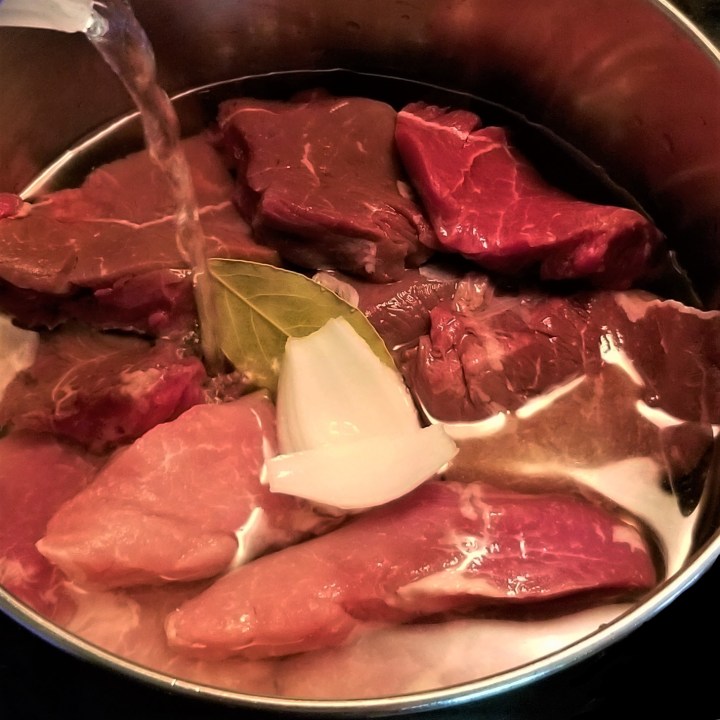
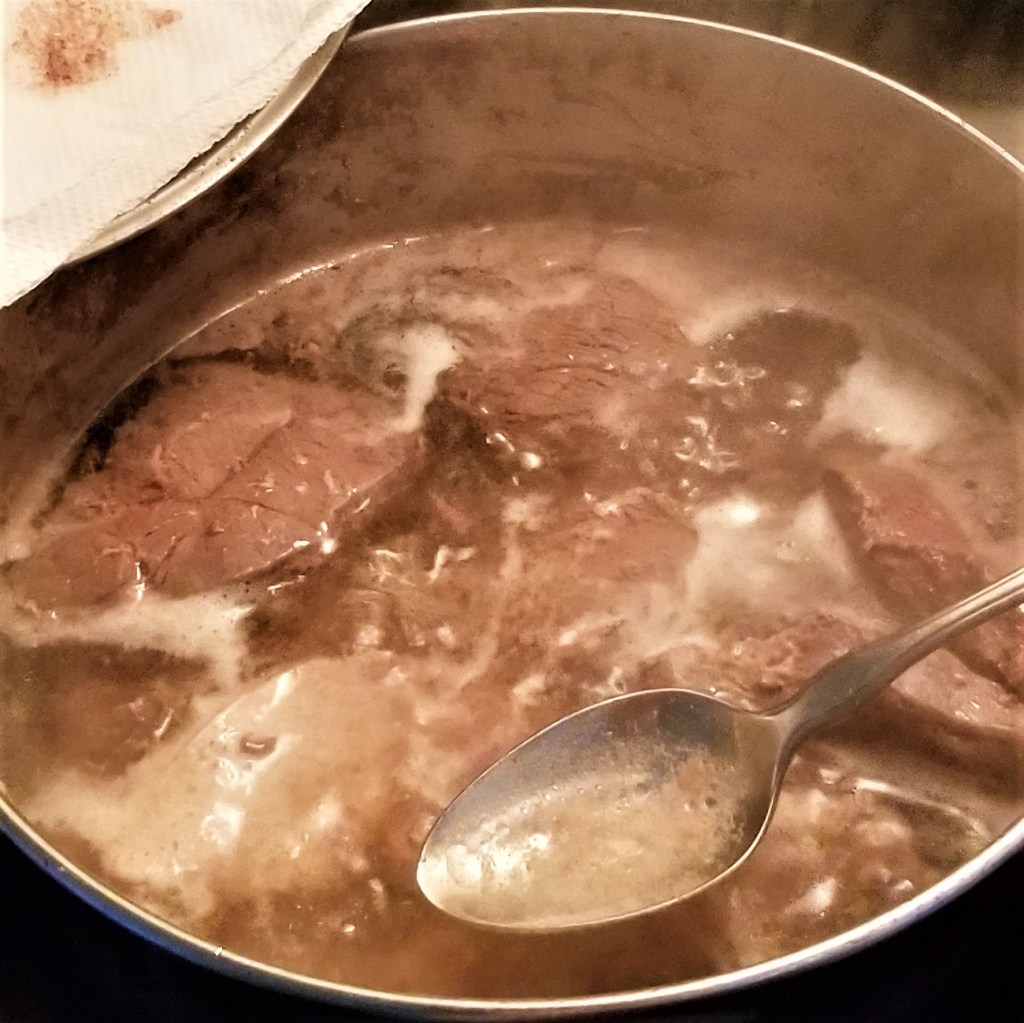
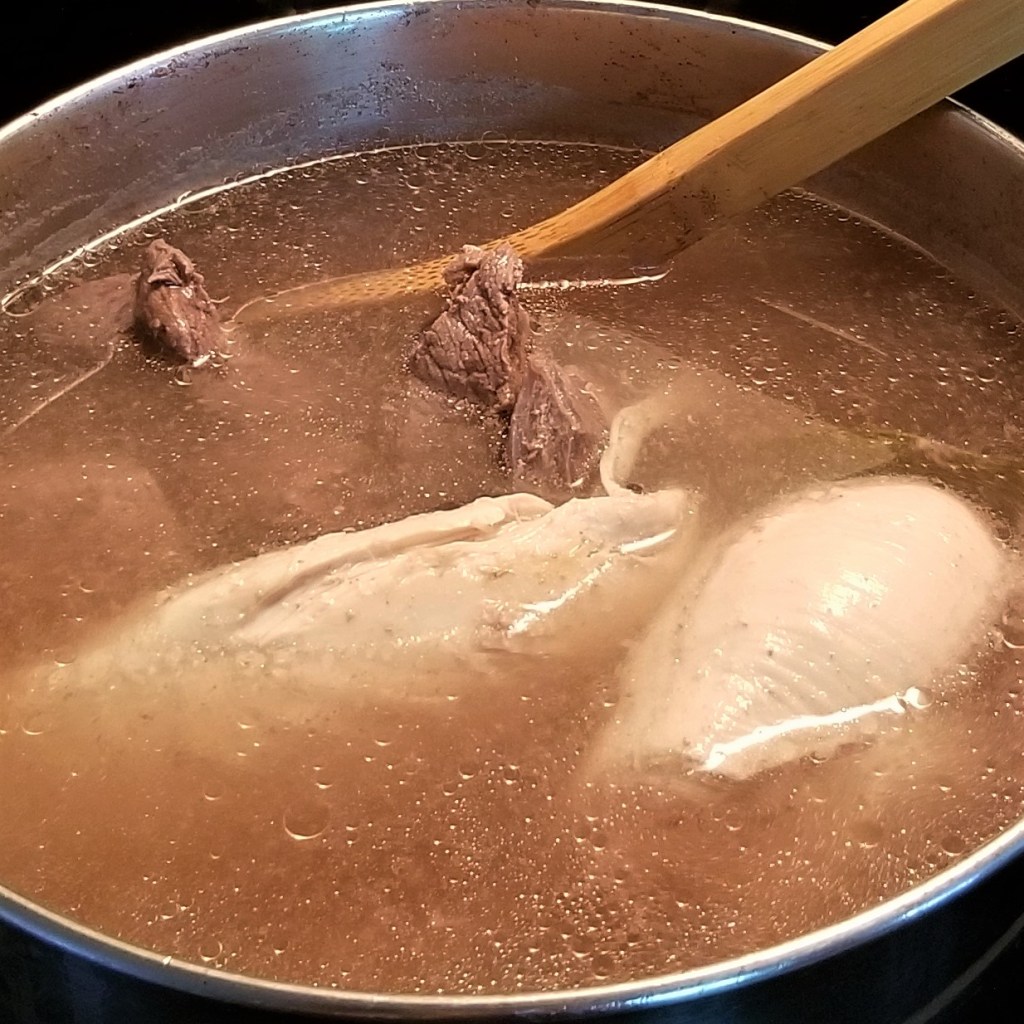
Prepare marinated radishes and red onion – Remove tops and bottoms from radishes; slice each in half lengthwise and slice thinly. Place in a non-metallic bowl, sprinkle with half a teaspoon of salt, or to taste, and the juice of half a lime (approximately two tablespoons, photo below, left); mix thoroughly and set aside. Slice red onion into half circles; place in a non-metallic bowl along with one tablespoon of chopped cilantro, juice from the other half lime, and half a teaspoon of salt, or to taste. Mix thoroughly and set aside (photo below, right):
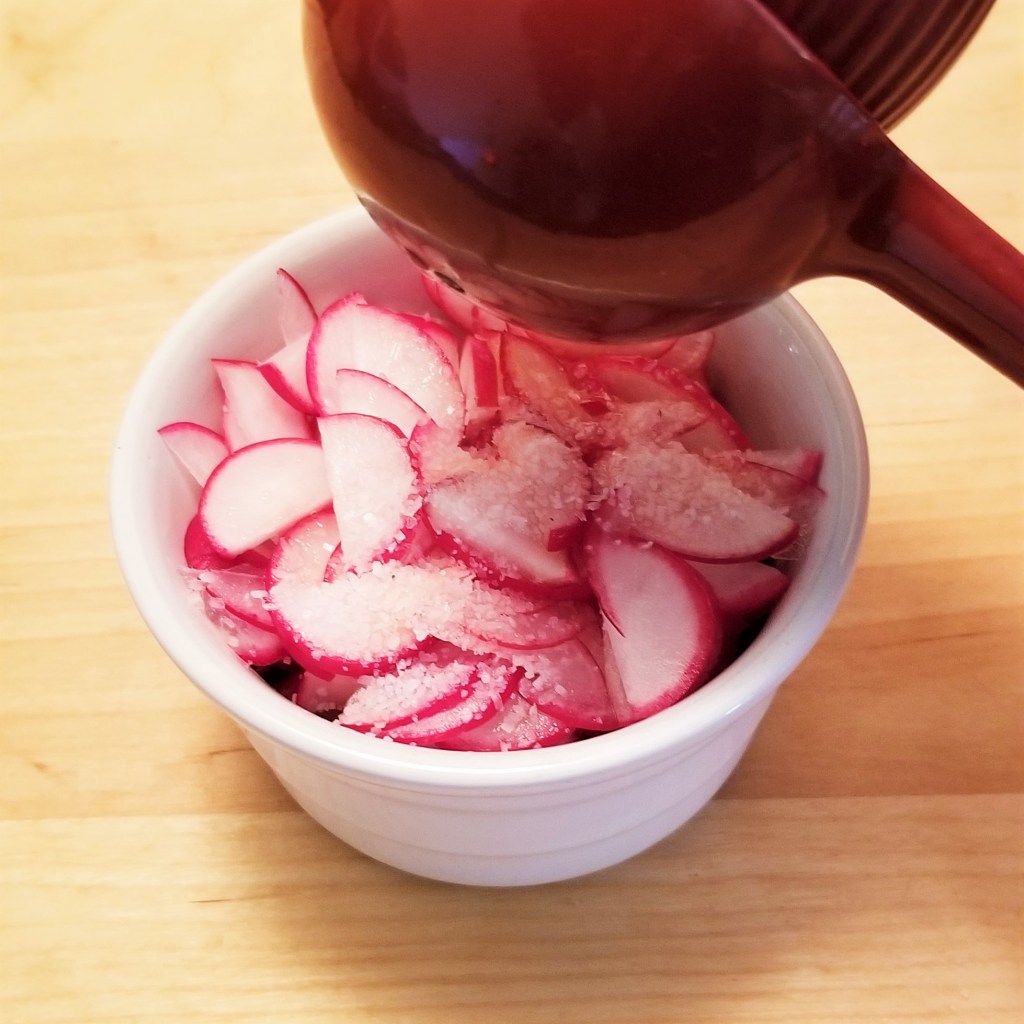
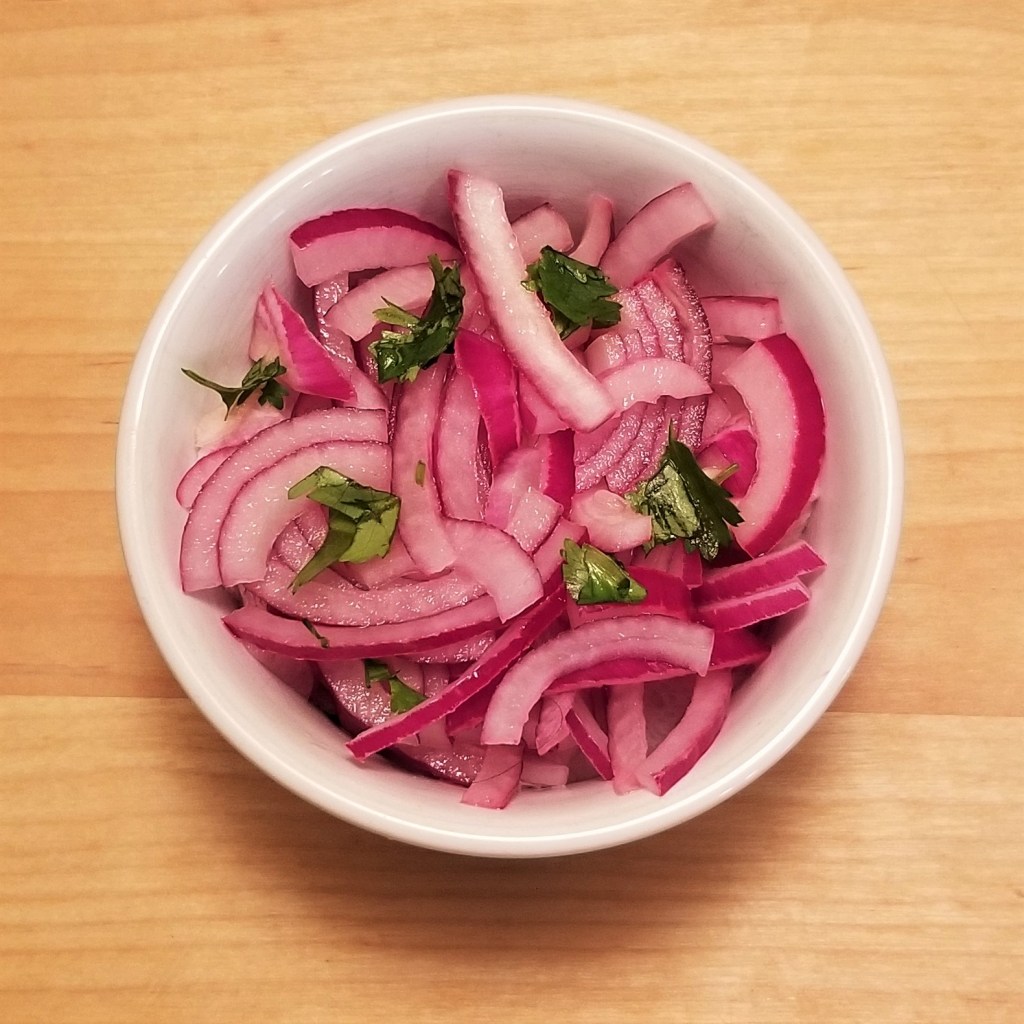
Roast peppers and aromatics – Remove stem and seeds from red sweet pepper, and slice into strips; reserve half for later. Remove stems and seeds from habanero peppers; wear gloves and do not touch your face, or use sweet pepper for a mild salsa (I chose the latter). In a heavy pan or skillet, dry roast (no oil) half of the red pepper strips, one quarter of white onion, the garlic cloves and the habanero (or sweet) peppers. Turn frequently until slightly charred, being careful not to burn the garlic (photo below, left). Remove from heat and reserve red pepper strips, onion and 1 clove of garlic. Transfer roasted habanero (or sweet) peppers and the rest of the garlic to a blender jar; add orange juice, the juice of one lime, and half a teaspoon of salt, or to taste (photo below, right):
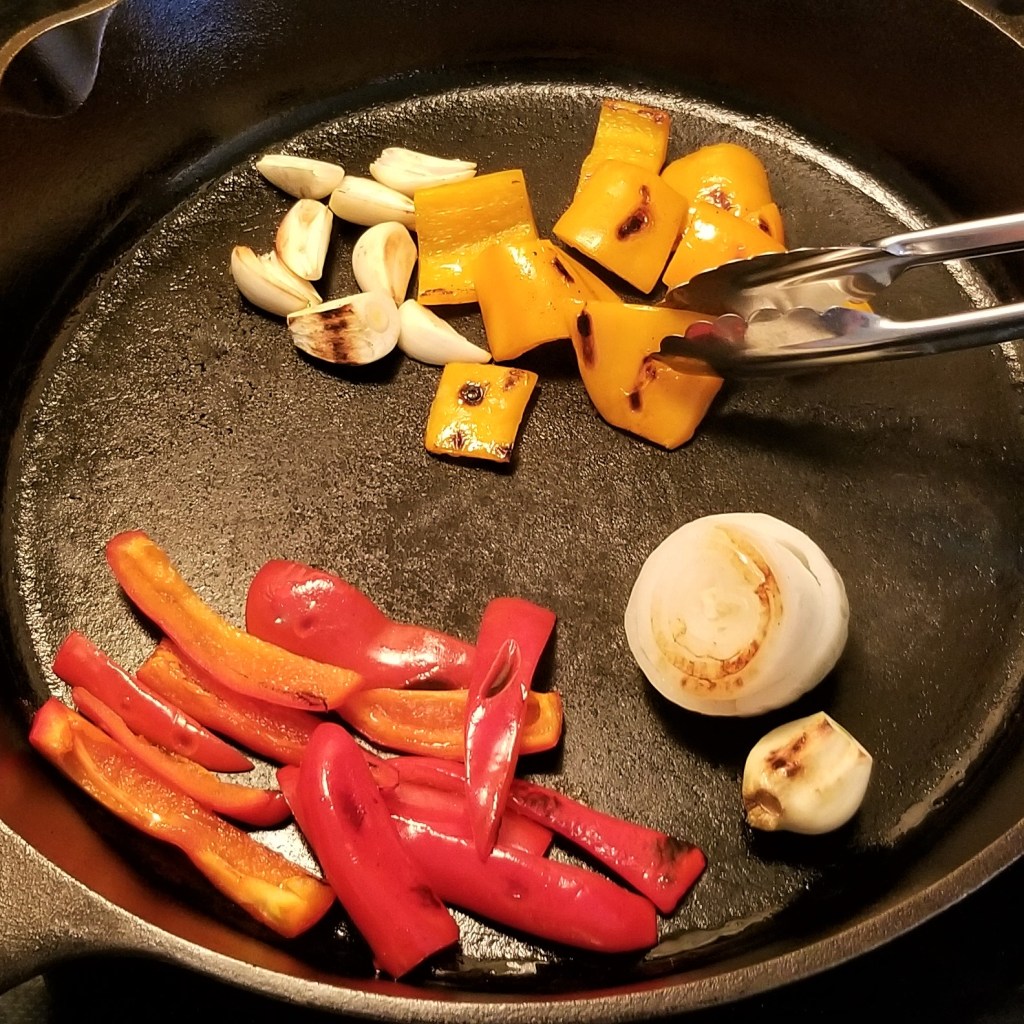
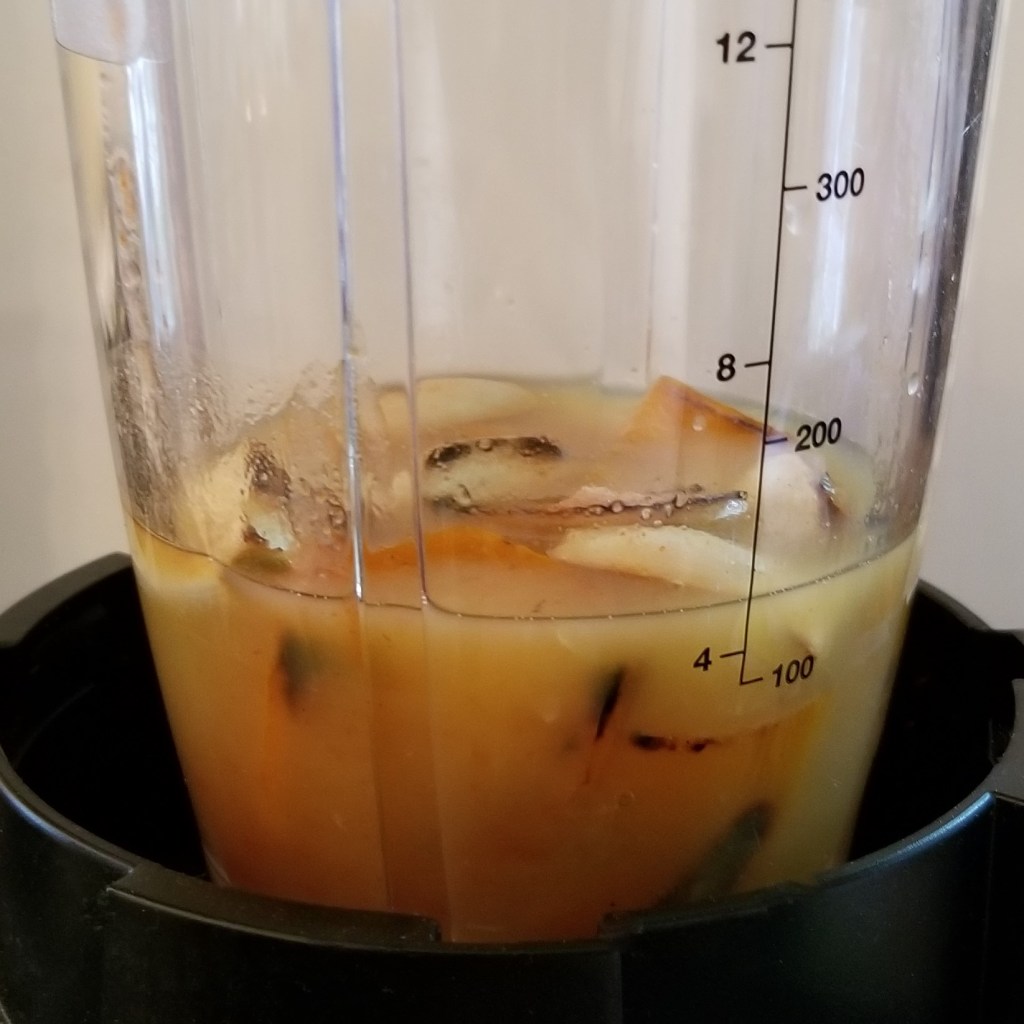
Prepare salsa – Process ingredients in the blender for a few seconds, not until completely pureed, leaving small pieces, for a runny salsa with some chunky texture. Pour into a bowl and reserve. These sides and salsa may be prepared the night before up to this step, and kept covered in the fridge, until one hour before serving time.
Set up ingredients for rice – rinse rice in a bowl, changing water at least twice, then drain onto a colander; shake colander to remove any excess water, and set aside. Measure two cups of water in a measuring cup, and add half a teaspoon of salt, or to taste, and a quarter teaspoon of saffron (for this step, I chose an envelope of powdered product, see photo); mix and set aside. Finely chop reserved half of raw red sweet peppers, and the last two quarters of white onion, and set aside.

Set up flavourings – Cut the lemon and the third lime lengthwise, then slice into half circles; set aside. Set the second tablespoon of cilantro and the spearmint aside. Measure and place ground cinnamon, cloves and all-spice in a small bowl, along with a quarter teaspoon of saffron. For this step, I chose unground saffron strands (see photo); set aside.
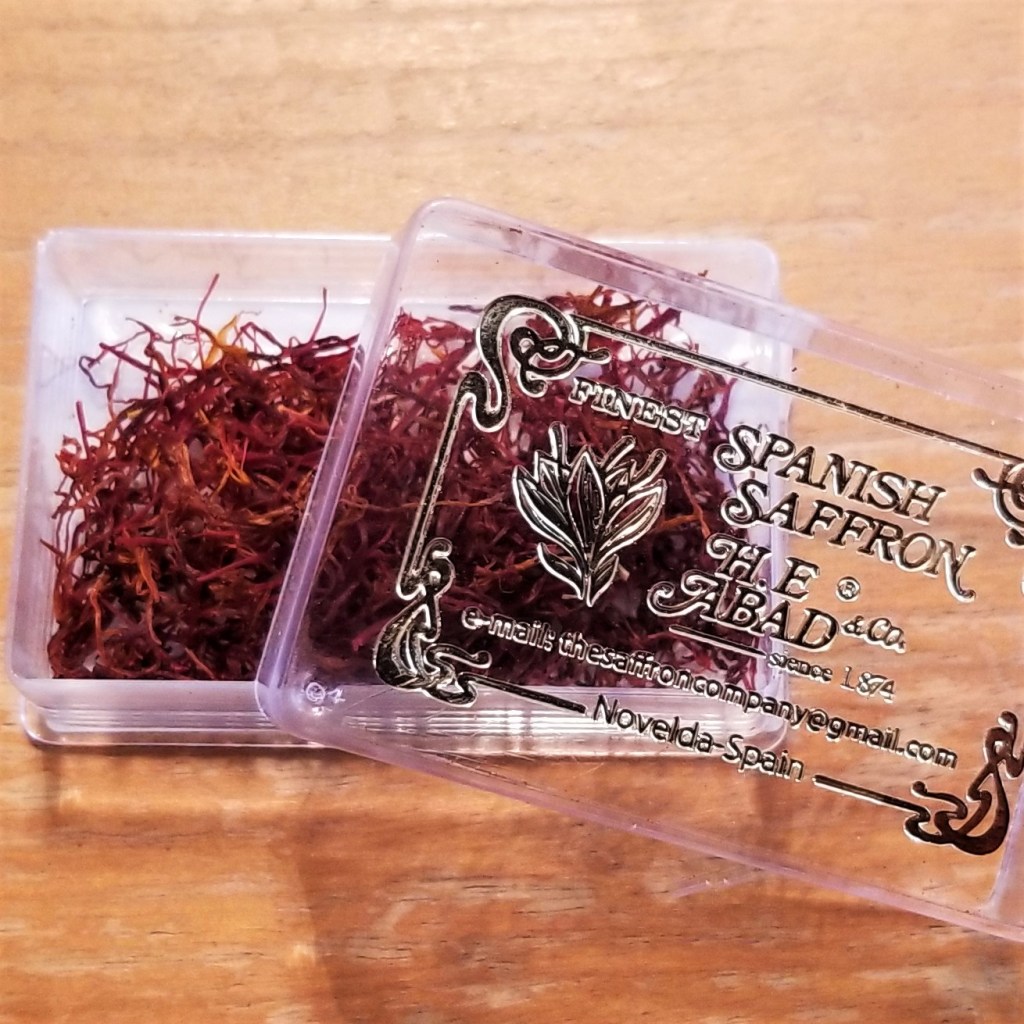
Prepare noodles for stew – Warm up two tablespoons of oil in a small pan over medium heat; add pasta noodles (photo below, left), and fry until slightly browned, stirring constantly to avoid burning (photo below, right):
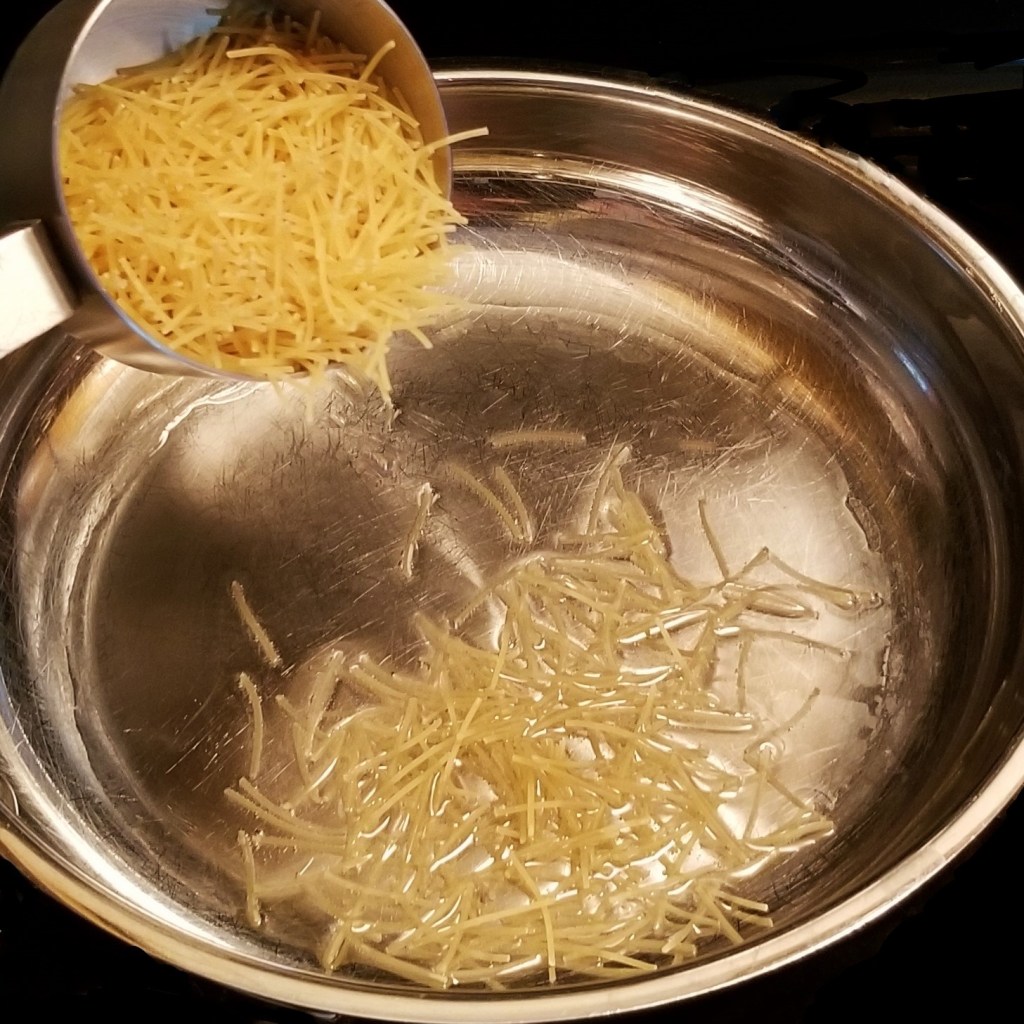

Promptly remove from heat and set aside.
Prepare vegetables for stew – For a traditional puchero campechano, chayote, carrot, potatoes, sweet potatoes, and kohlrabi are peeled, then, as shown below, clockwise from top left: chayote squash sliced into eight pieces; carrot halved and cult into sticks; ear of corn and squash (zucchini) divided into 2-inch cylinders; potatoes and sweet potatoes in large chunks and immersed in cold water to avoid browning; plantain cut into 2-inch slices (unpeeled); cabbage cut into three pieces; at the centre of the photo, kohlrabies quartered:
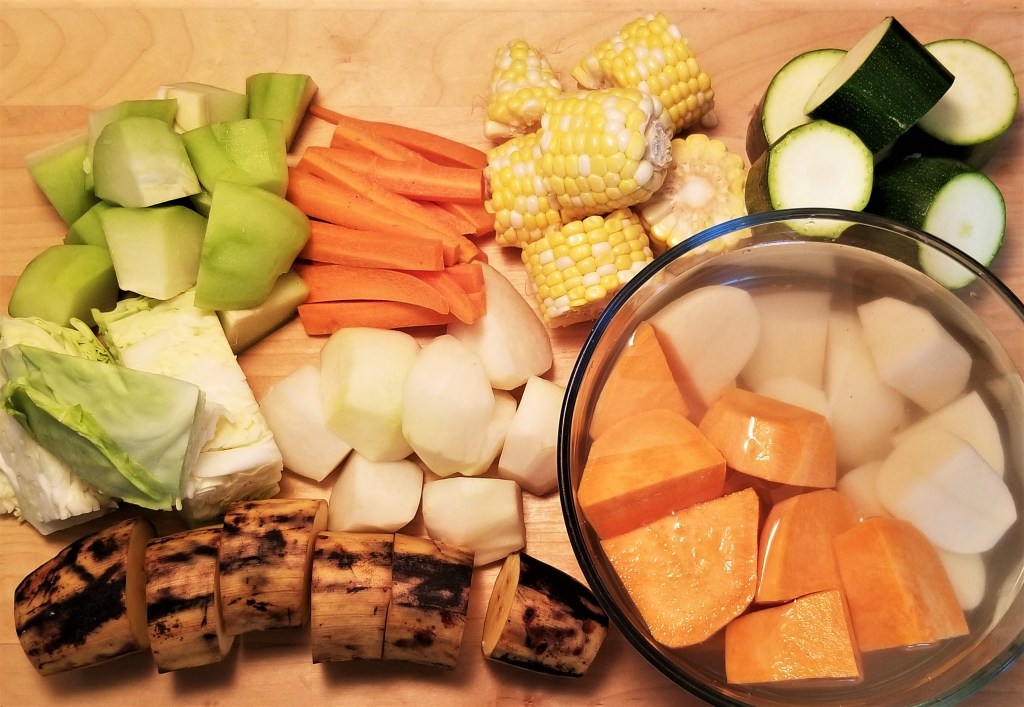
For my version, peel chayote, carrot, potatoes, sweet potatoes, kohlrabi and plantain then, as shown below, clockwise from top left: dice chayote and carrots; shave corn kernels off the cob; cut zucchini into quarters lengthwise and then slice; dice potato and sweet potato; peel plantain, cut in half lengthwise and slice (keep in a plastic bag to avoid browning); cut cabbage into six pieces; at the centre of the photo, kohlrabi cut into short sticks:

Process cooked meat (skip for vegetarian) – At this point, in the traditional recipe, once the meats are fully cooked, the chunky veggies are added to the pot gradually, then all is cooked until serving time, but in my version: remove meats from the pot, discard skin and/or bones, and chop or shred into bite-size pieces; reserve. In the photo below, left to right, shredded chicken, and chopped beef and pork:
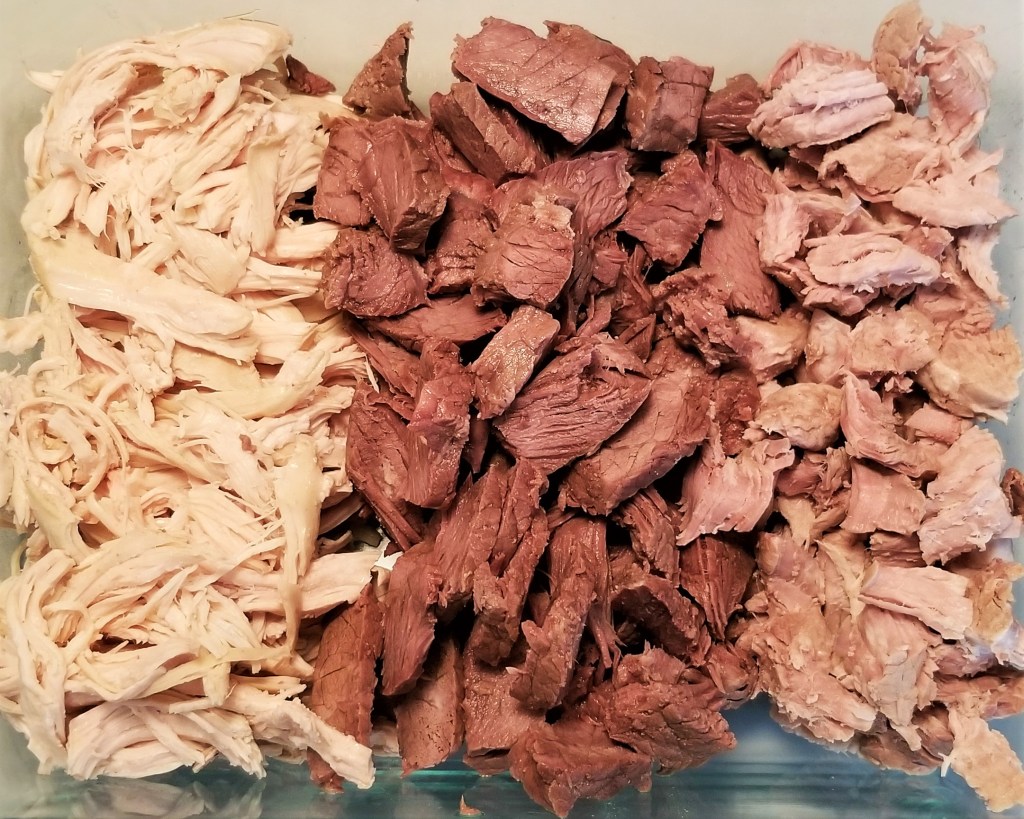
Assemble and cook stew – Strain broth through a mesh onto another large pot over high heat:
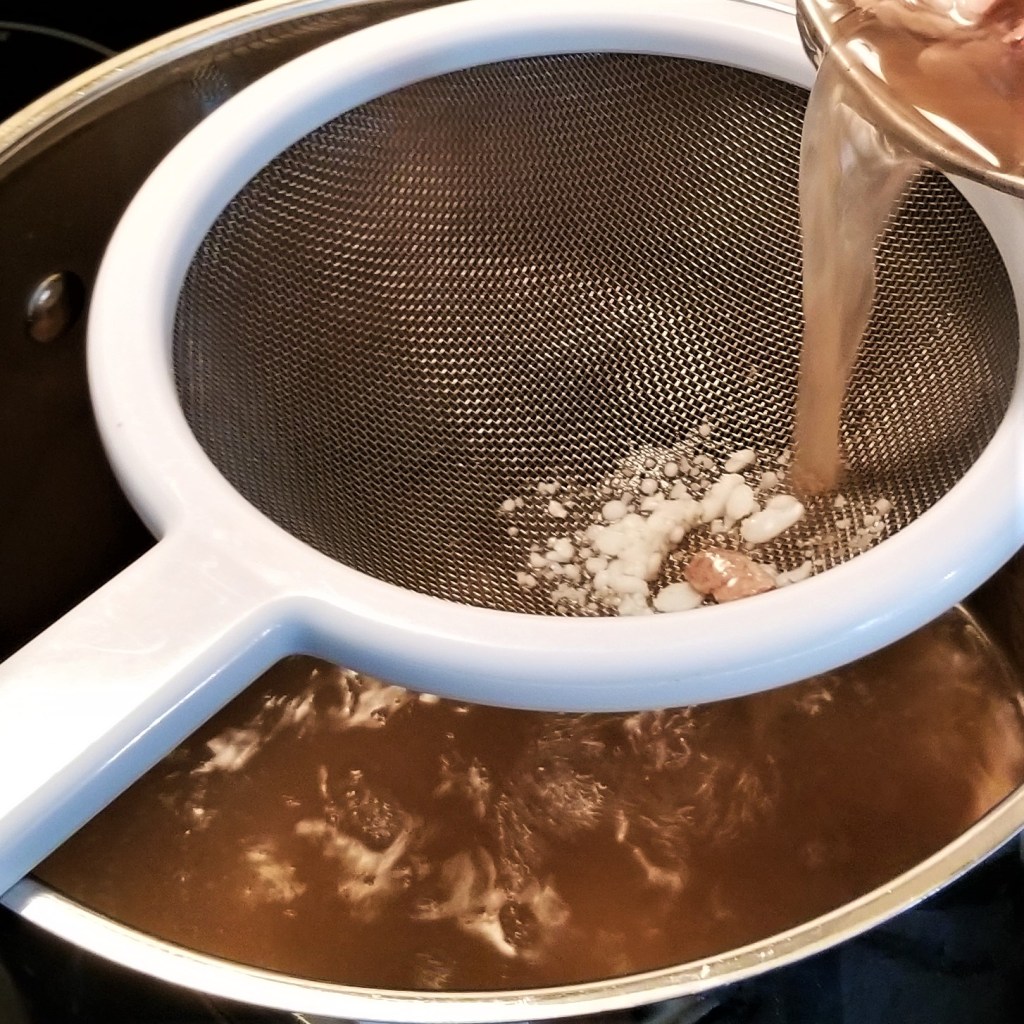
Note: For vegetarian option, bring six cups of water to boil in a large pot over high heat, then add the bay leaf, one quarter of the white onion and a tablet of mushroom bouillon mix (see photo). Continue directions.
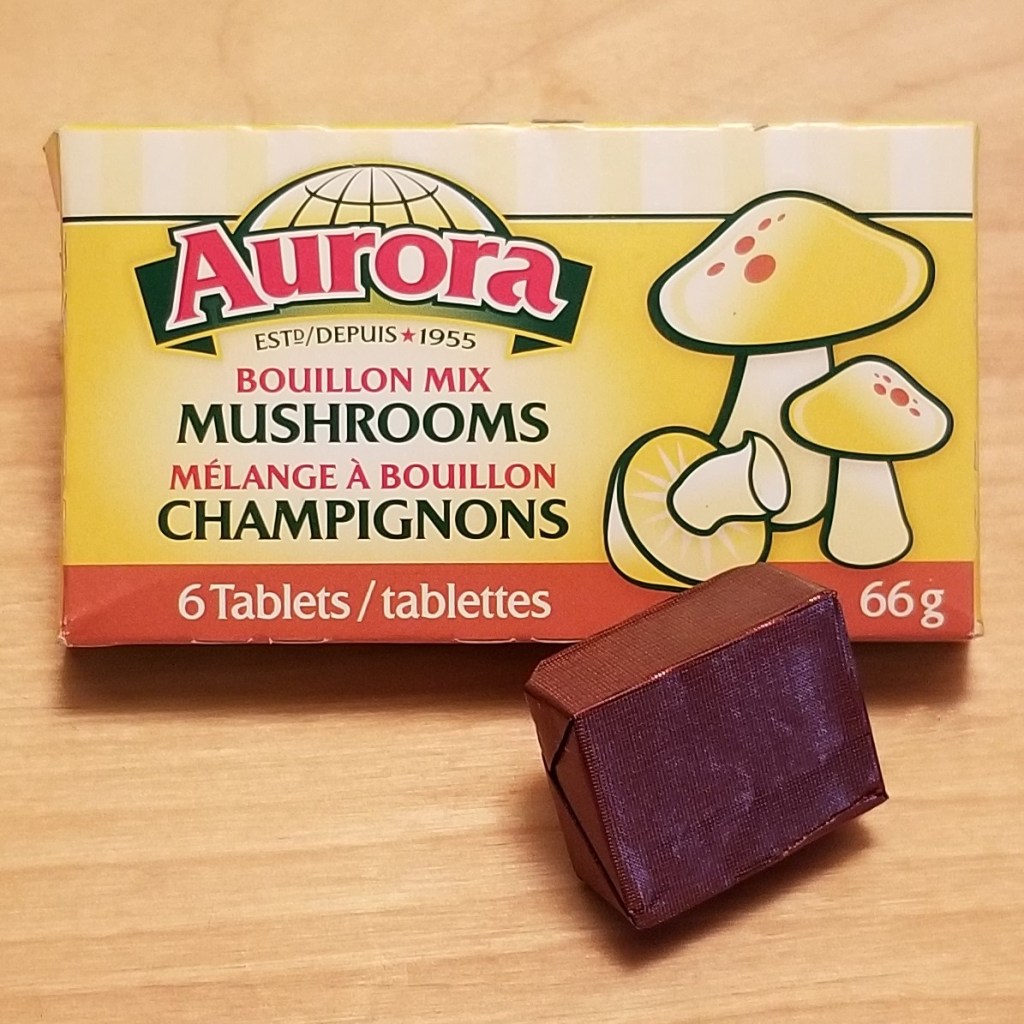
Once the broth is boiling, add carrots and allow to cook for two minutes, then add chayotes (photo below, left). After another five minutes, add corn kernels (photo below, right):
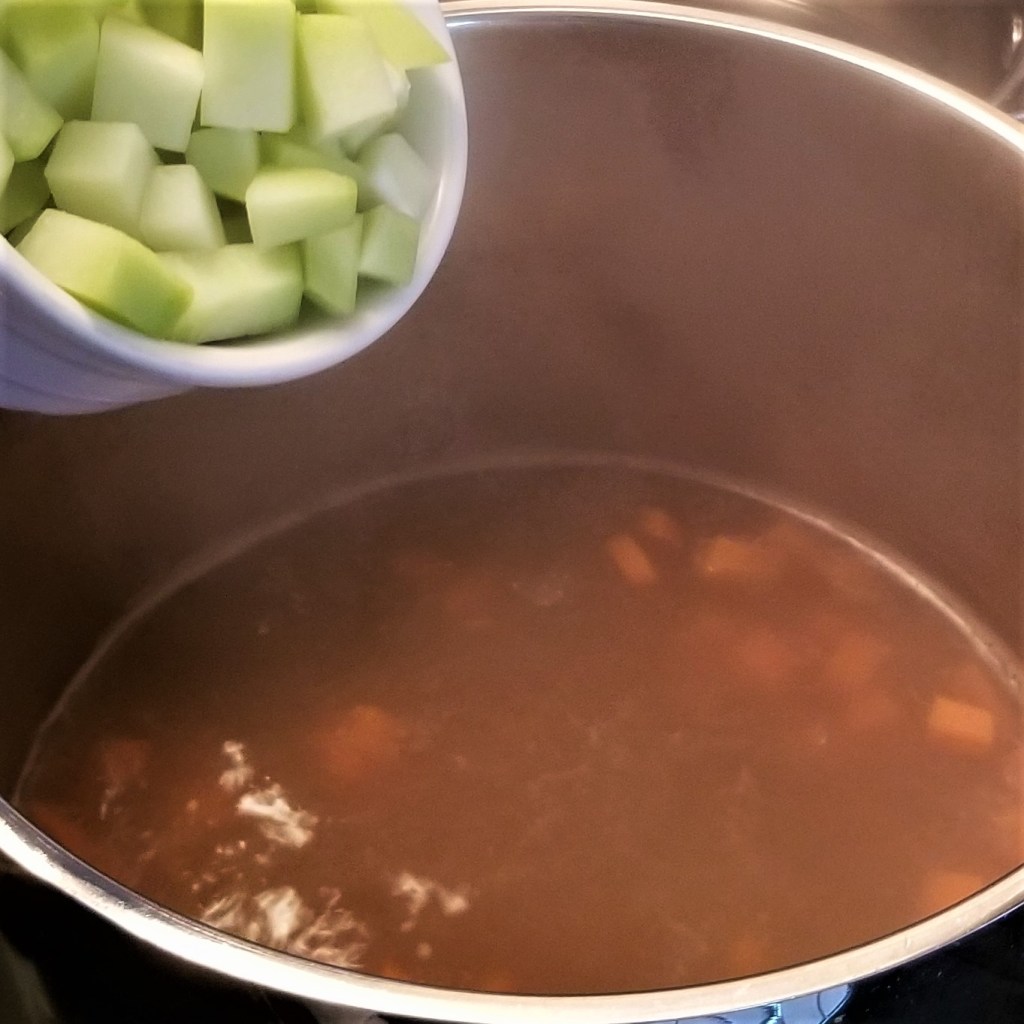
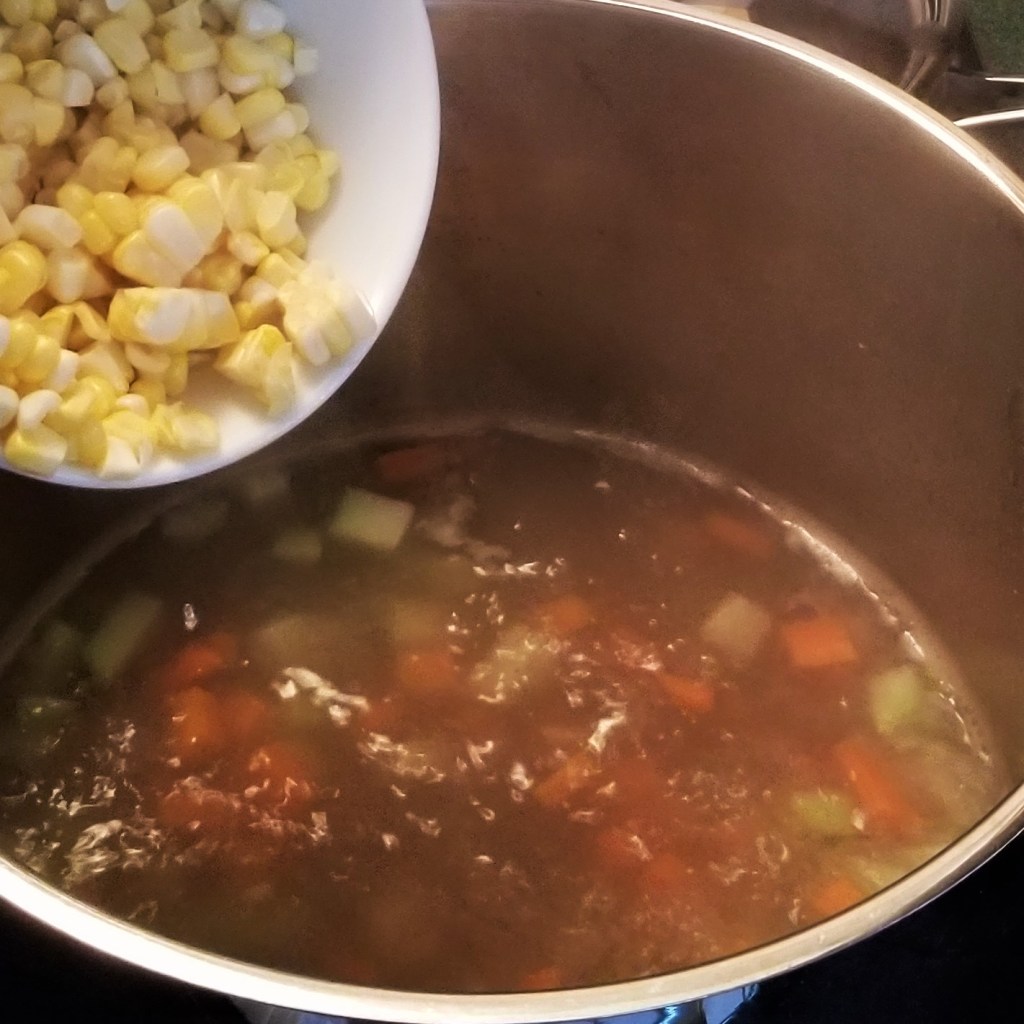
Adjust heat to bring to a simmer, and cook for a few minutes.
Start saffron rice – Meanwhile, bring all reserved ingredients for rice near the stove. In another large pan with lid, warm up two tablespoons of oil over medium heat, then add and sauté the reserved chopped onions and sweet peppers (photo below, left); after a minute, add drained rice (photo below, right):
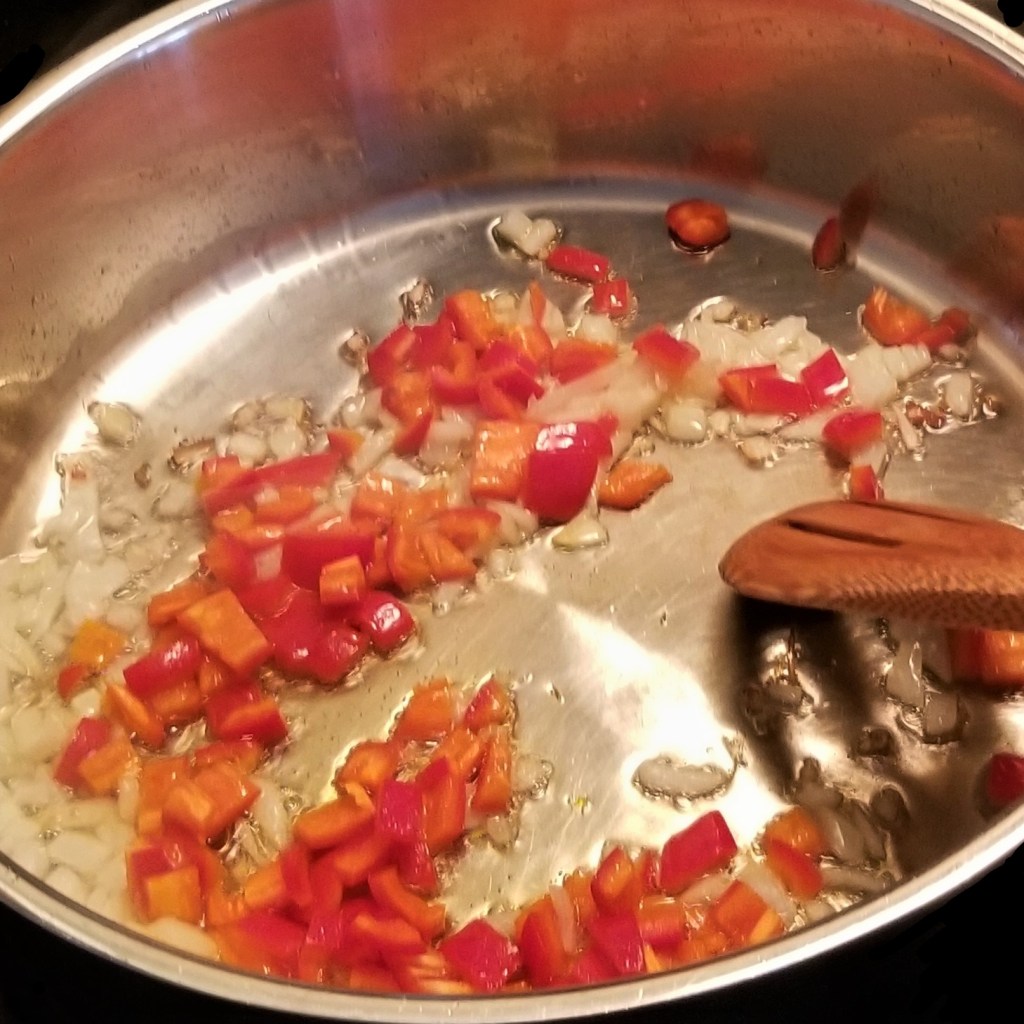
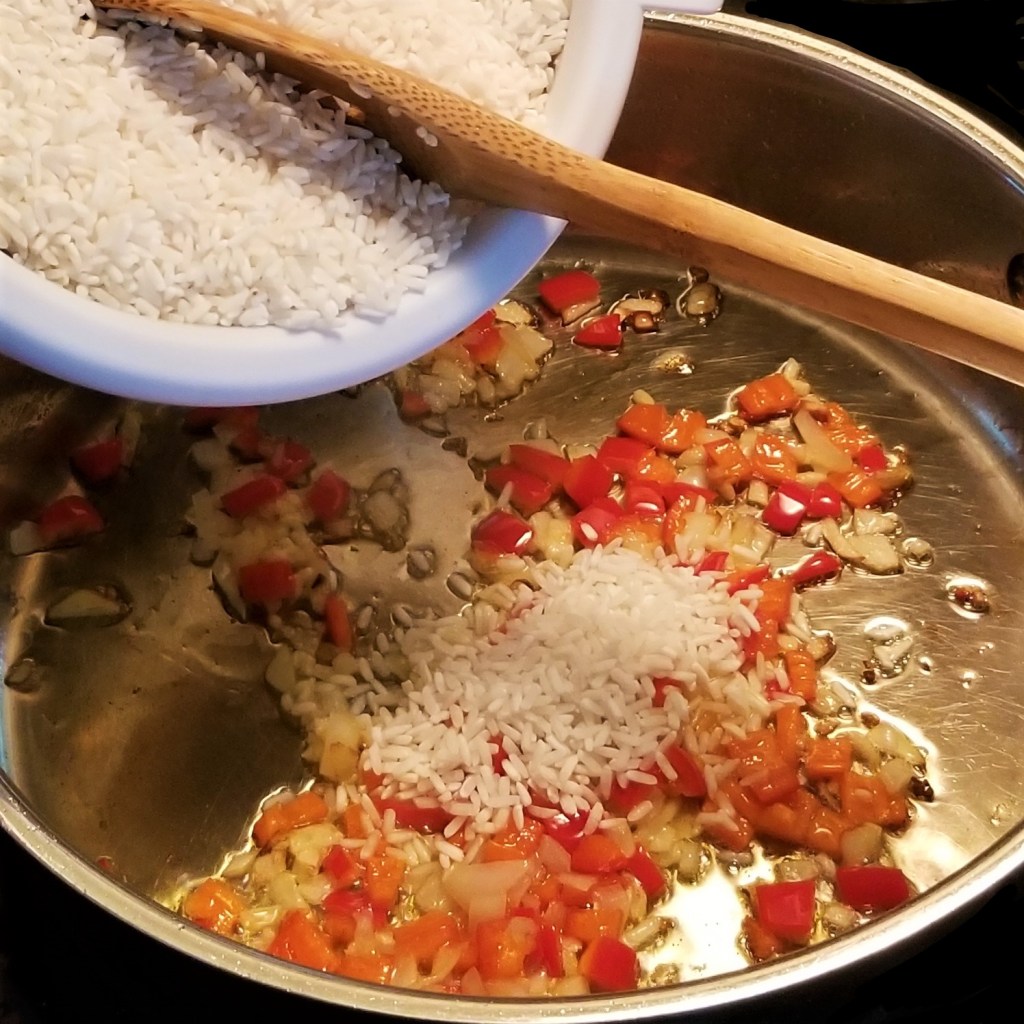
Stir rice with the veggies, to coat with oil, and continue cooking until the rice slightly browns, and becomes fragrant, stirring constantly to avoid burning. Promptly pour in the salted water with saffron (photo below, left), and as soon as it boils, cover pan with lid and reduce to the minimum heat setting (photo below, right):
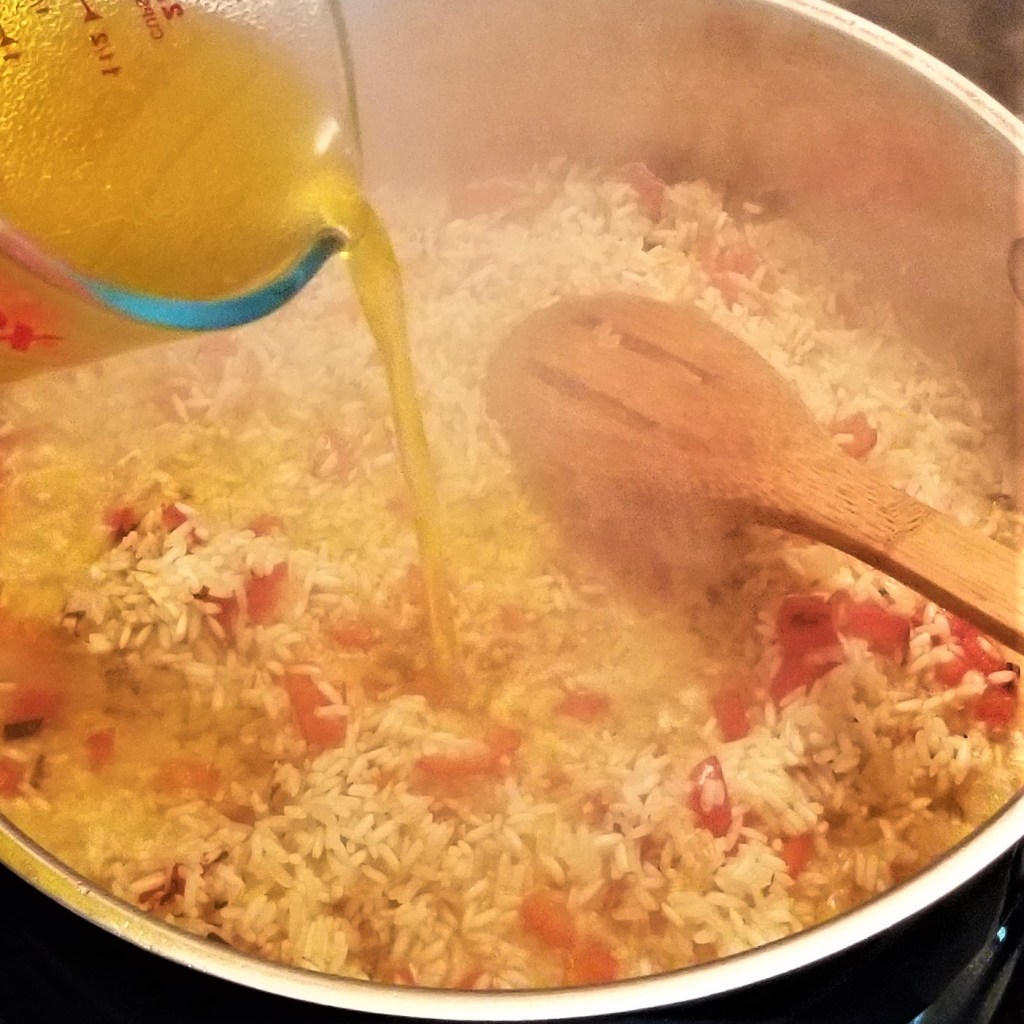
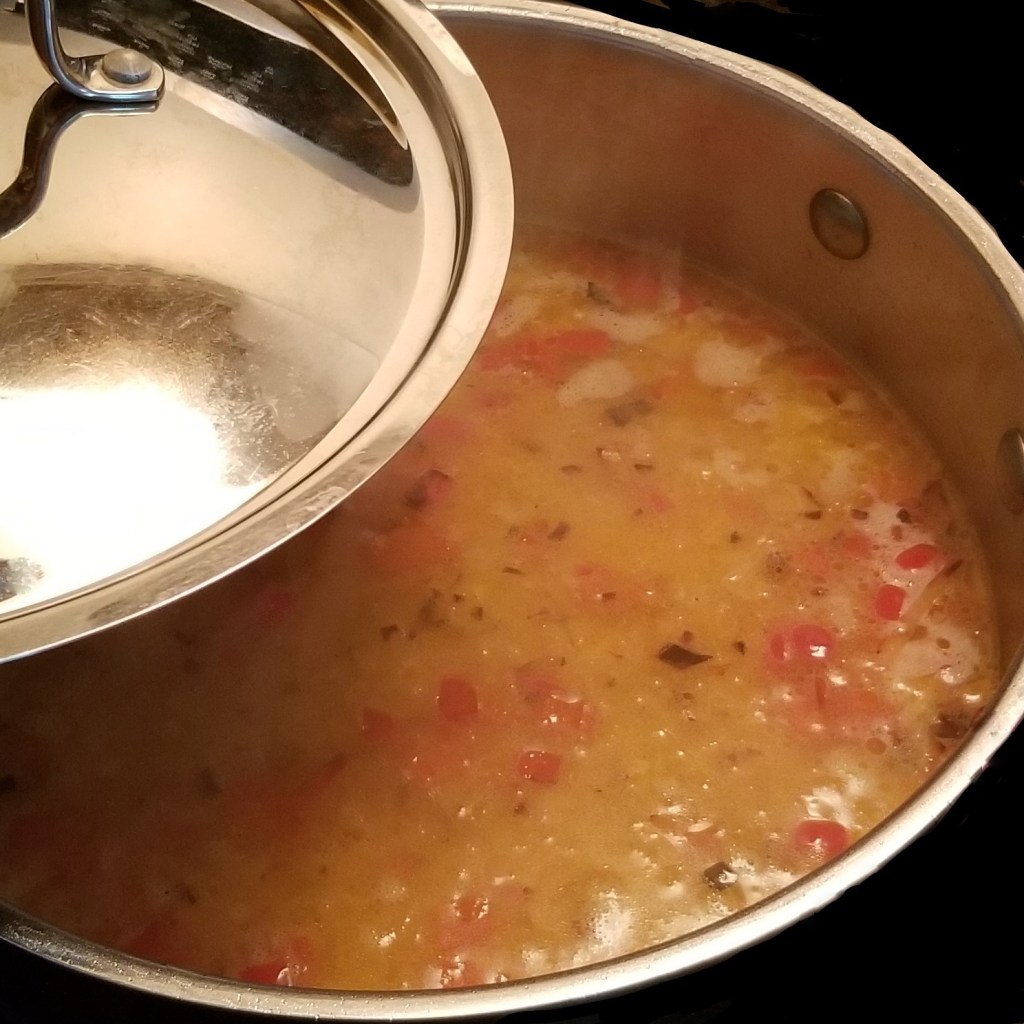
Allow to simmer, undisturbed, for twenty minutes.
While the rice simmers, back to the stew, drain diced sweet potatoes and potatoes and add to the pot (photo below, left); after five minutes, add kohlrabi (photo below, right):
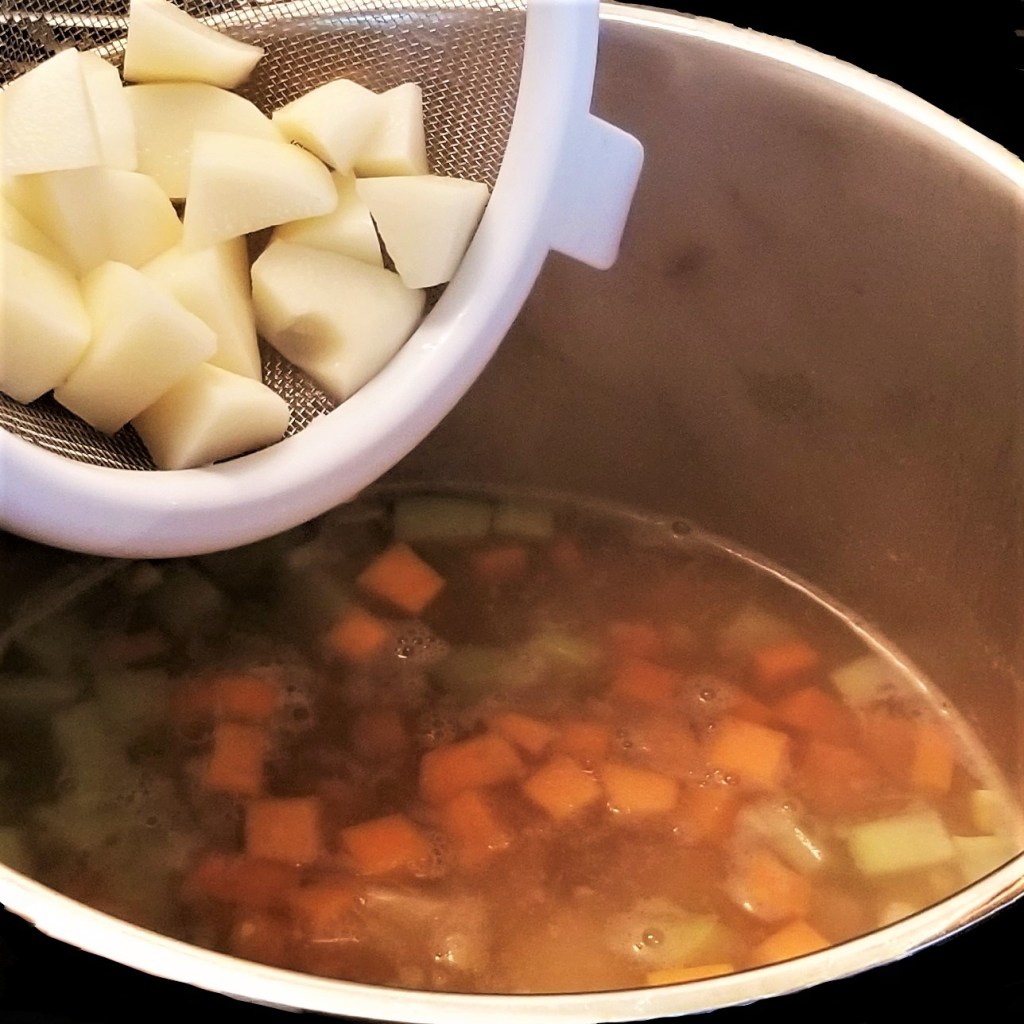
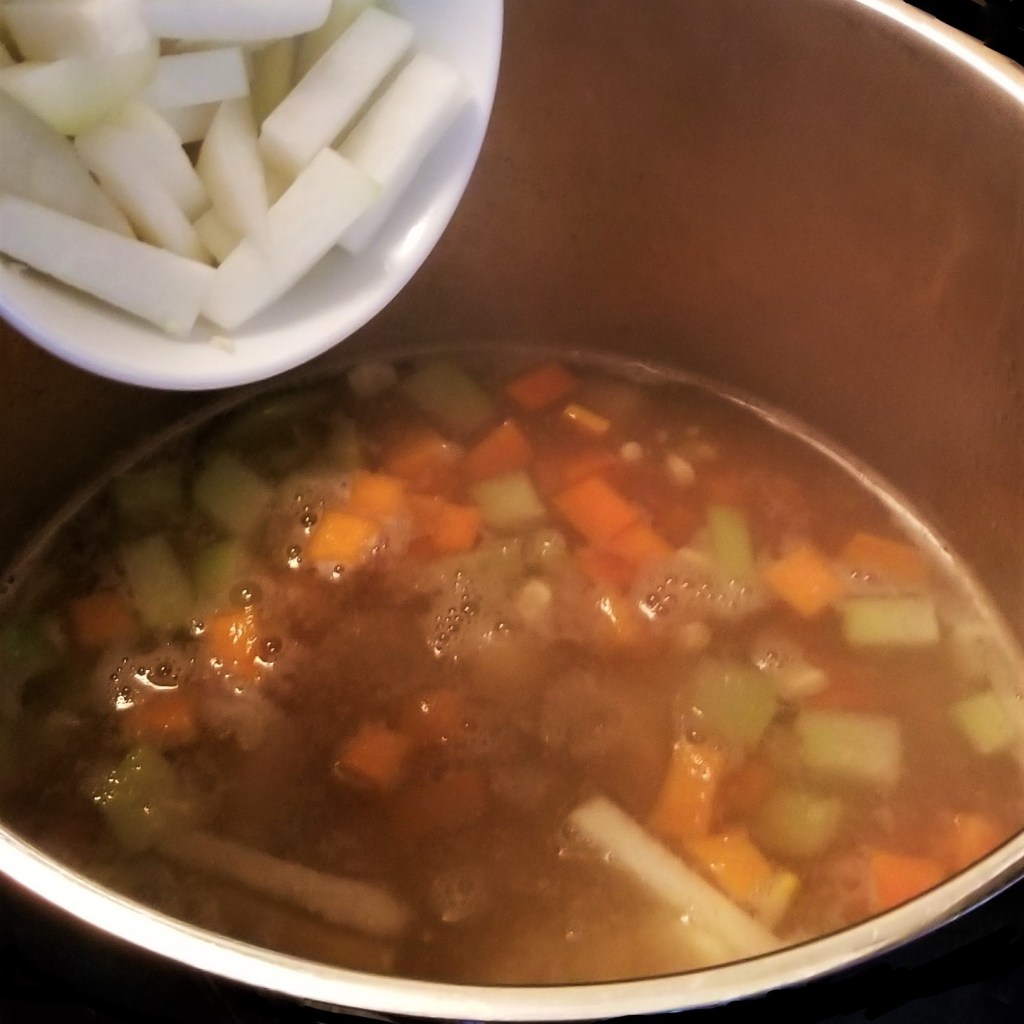
After a couple of minutes, add the reserved cinnamon, all-spice, cloves and saffron (photo below, left); allow to cook until potatoes are fork-tender, about ten minutes, then add zucchini (photo below, right):

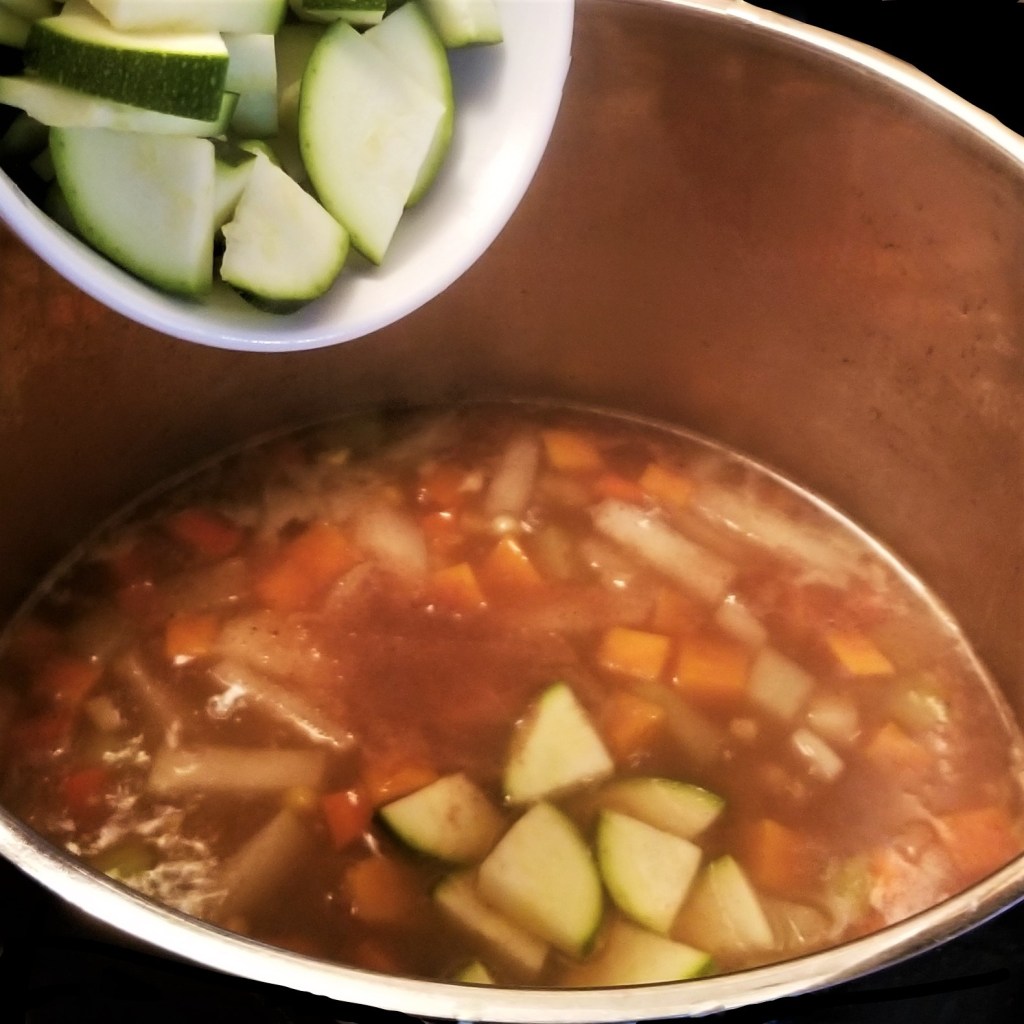
Next, add plantain, cabbage, and reserved roasted red peppers, garlic clove and onion (photo below, left). Add reserved cooked meats (skip for vegetarian), stir, and top with hot water, as needed, just to cover all ingredients (photo below, right):
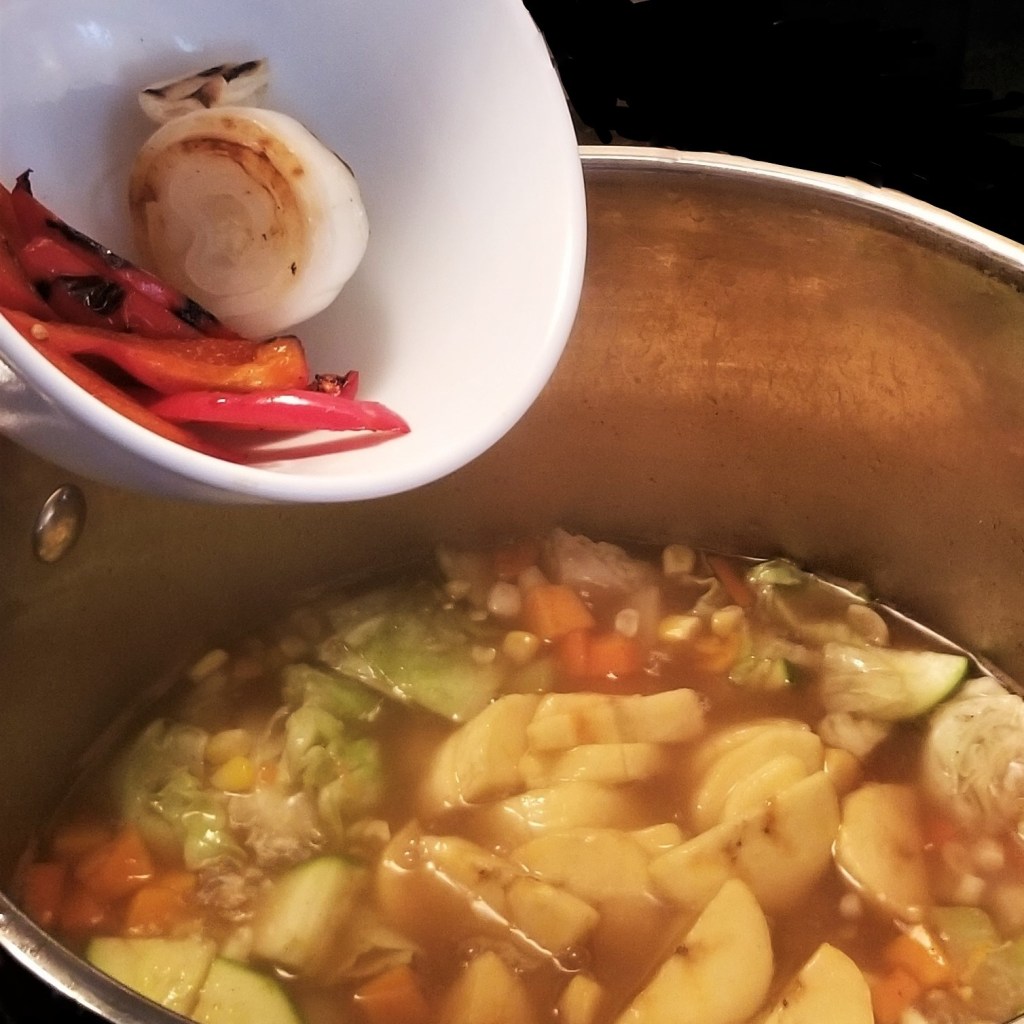
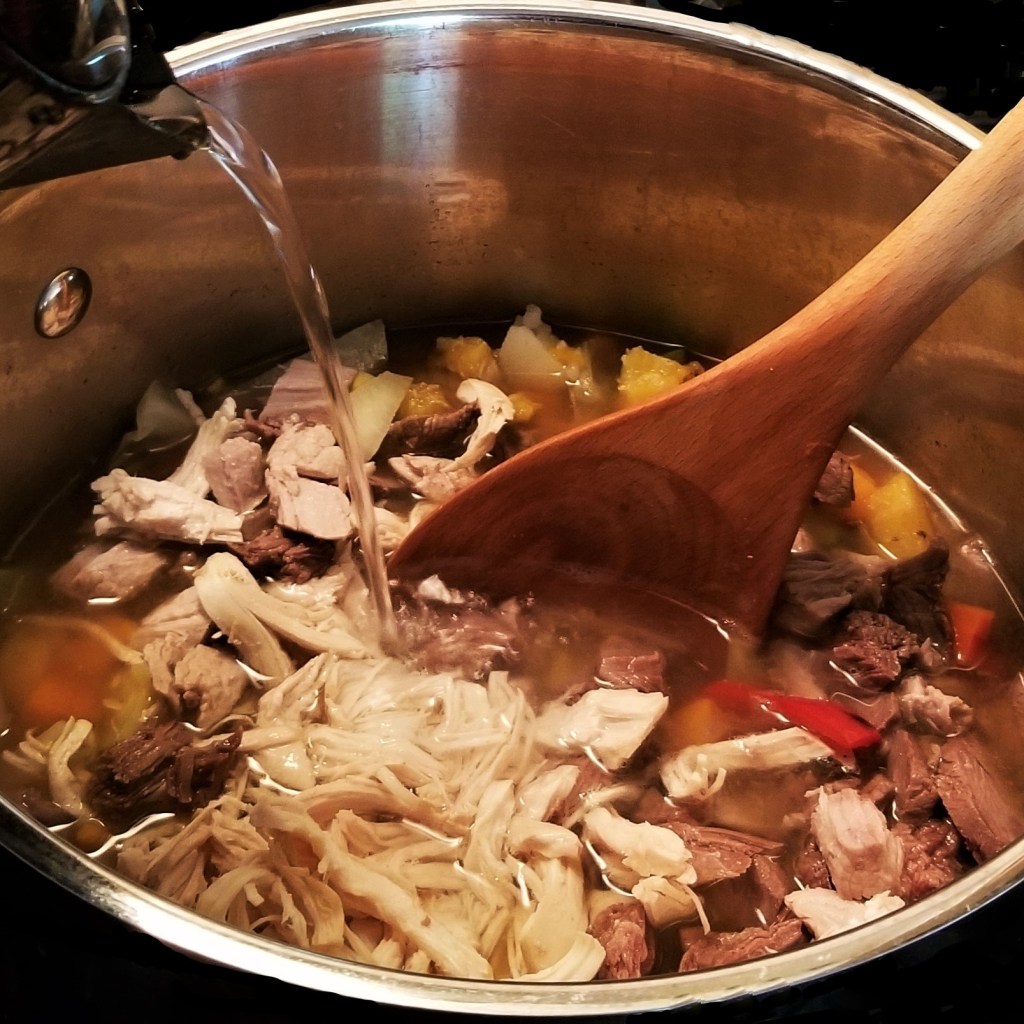
Bring back to boil, and simmer until meats are warmed up.
For vegetarian version: Remove bay leaf, add cooked green peas, and hot water, as needed, then continue recipe as regular version:
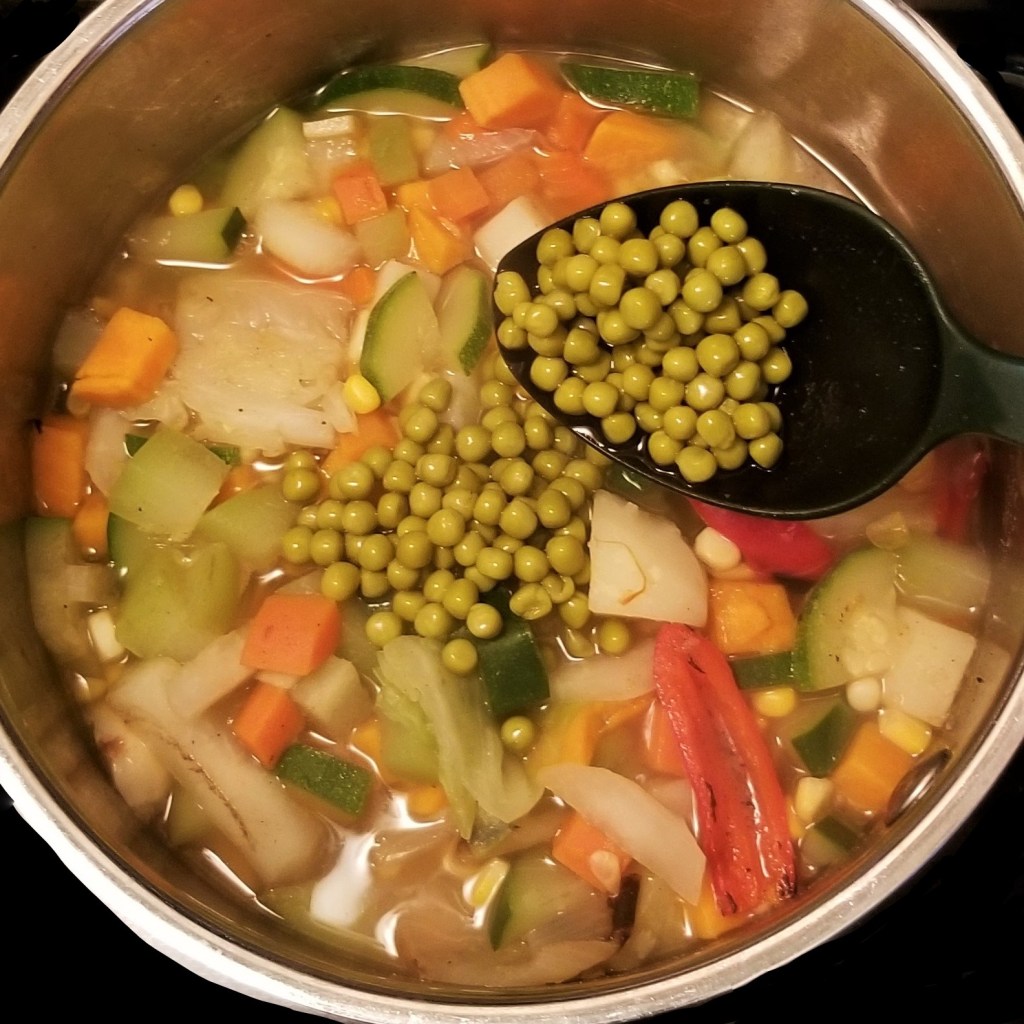
Meanwhile, back to the rice, after the twenty minutes are up, uncover and check that the water at the bottom has evaporated; turn off heat but leave pan on the hot burner, undisturbed, for five more minutes, then fluff rice with a fork:
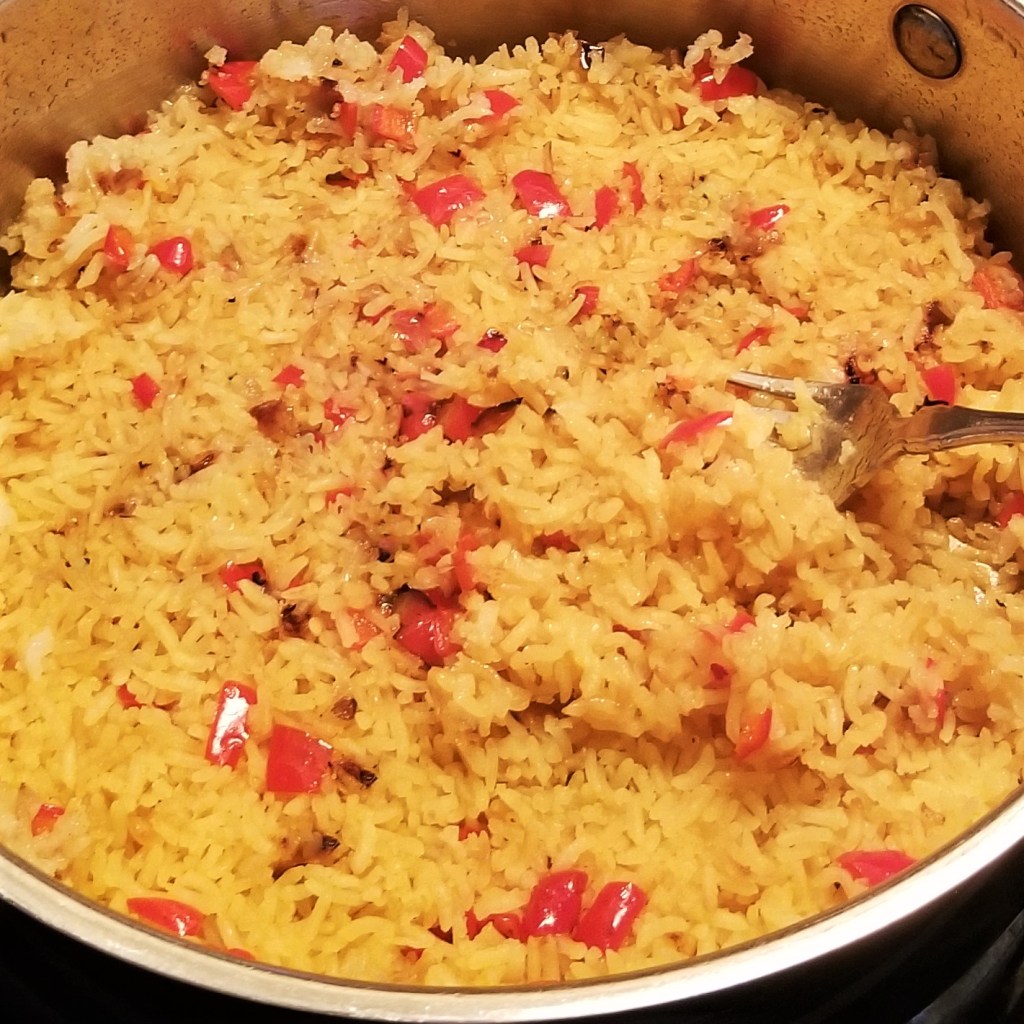
Move pan away from hot burner, and reserve until serving time.
Back to the stew, add reserved slices of lime and lemon, and herbs (spearmint and cilantro, photo below, left). Finally, adjust seasoning with salt and pepper, to taste, and just before serving, incorporate reserved fried noodles (photo below, right):
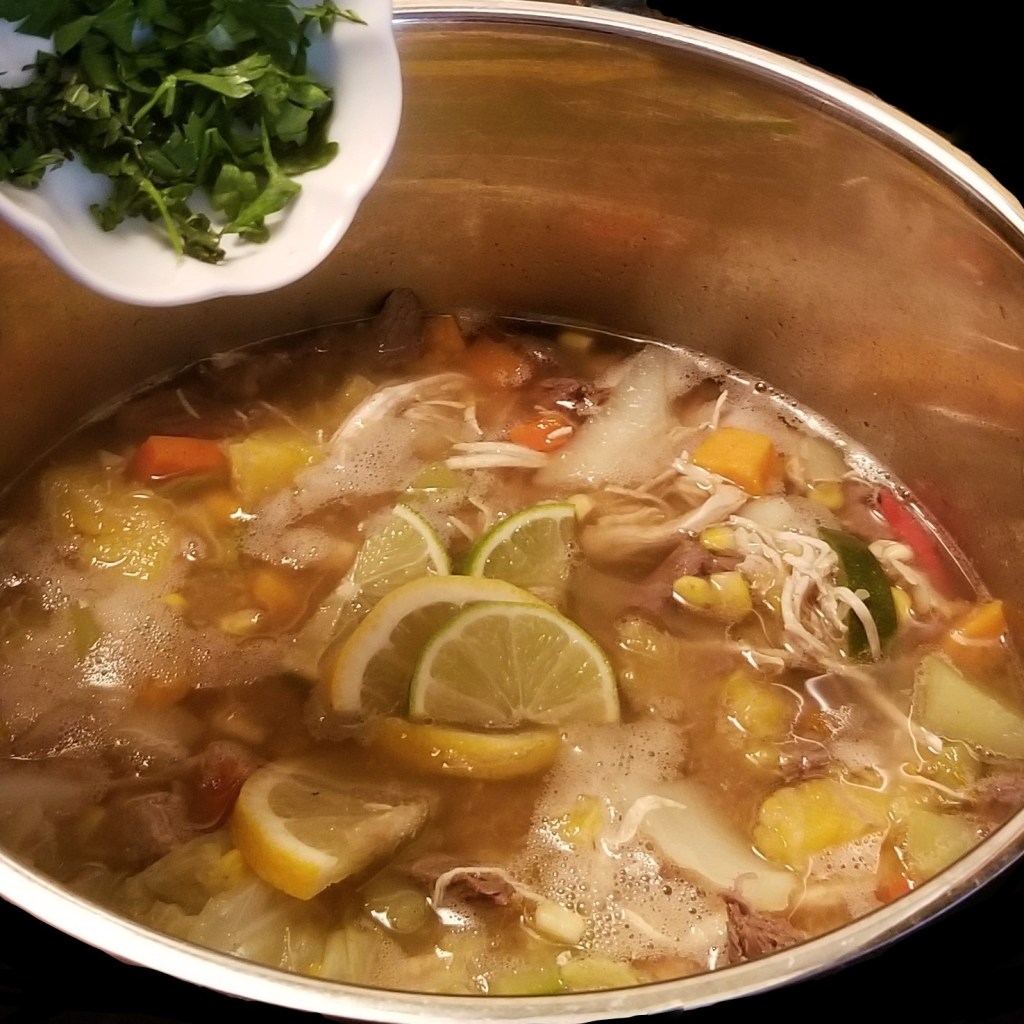
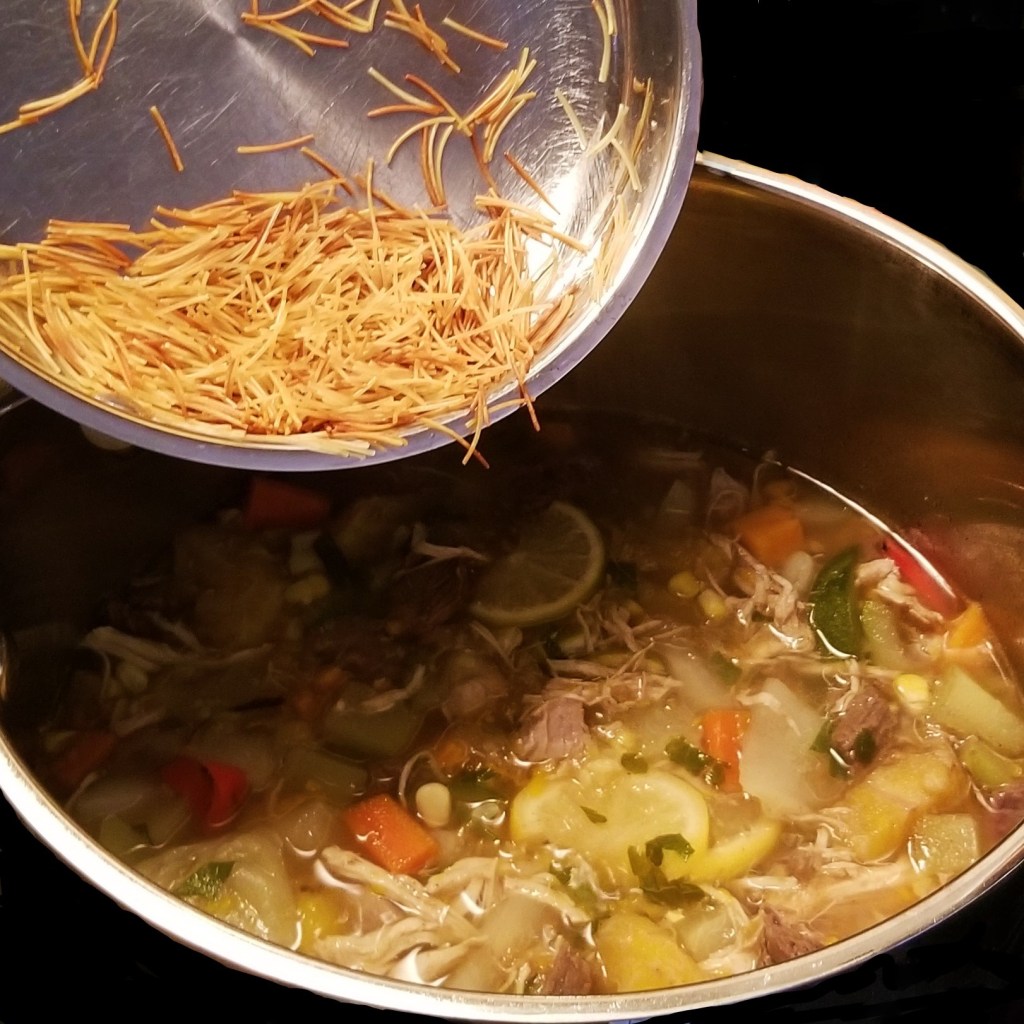
Slice and peel avocado and set in a bowl at the table, along with marinated radishes and red onions, and roasted pepper salsa:
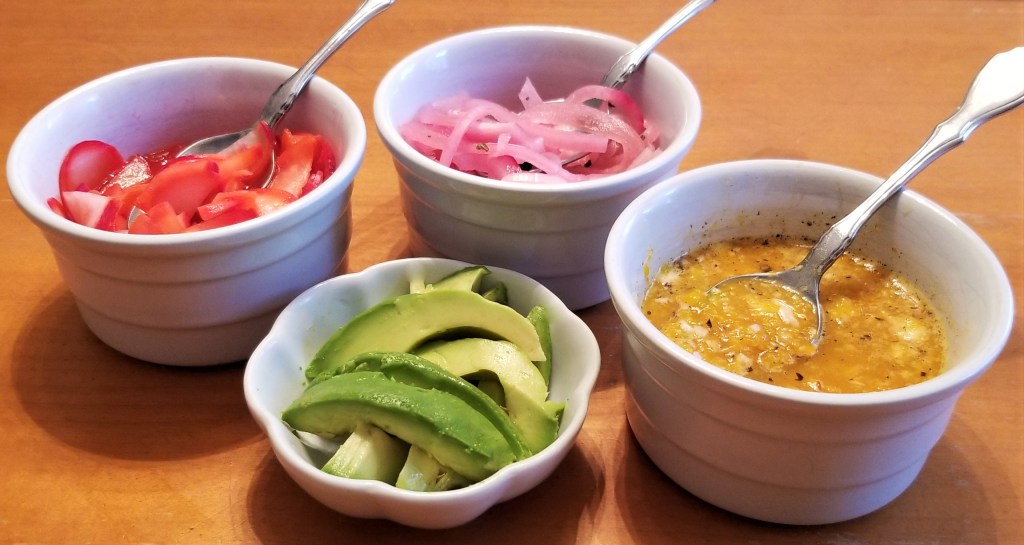
Serve generous bowls of puchero, with a side of rice, for each person to add condiments to their taste (photo at the top of this post), and offer warm tortillas (if using), as shown below for the vegetarian/vegan meal:
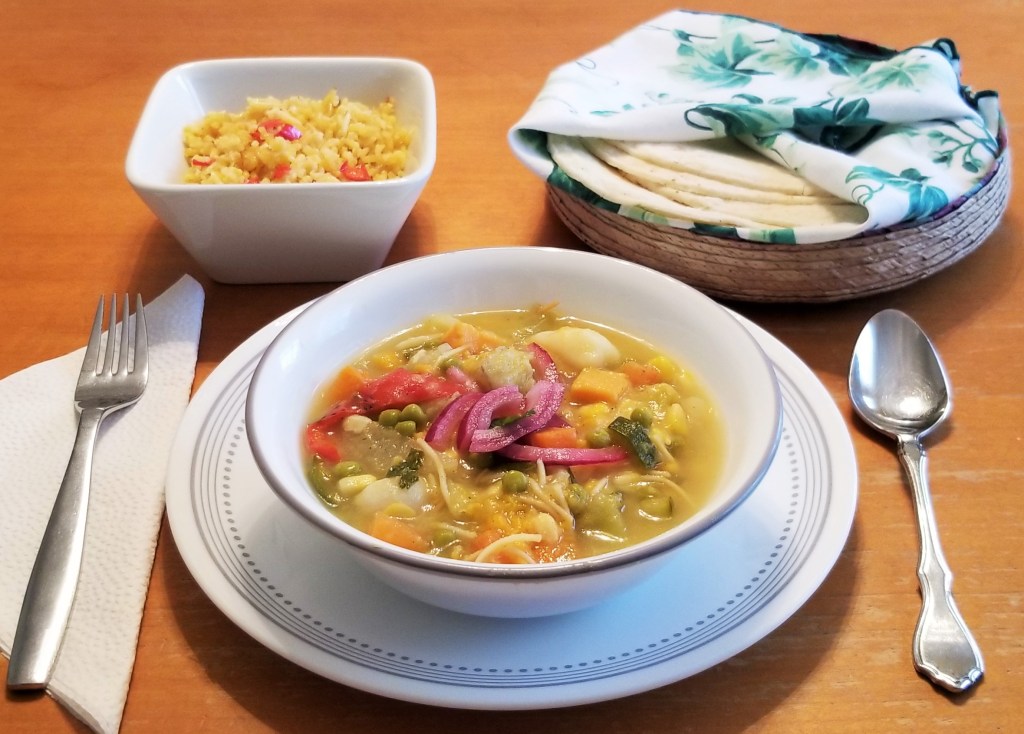
It was an intensive cooking session, but the end products were well worth the time and work; both my husband and I liked the dish very much, finding the balance of flavours just ridiculously perfect: the sweet and sour fruits, the starchy roots, the fresh and roasted vegetables, the spices and herbs, the three meats, oh my, so much going on in that bowl:
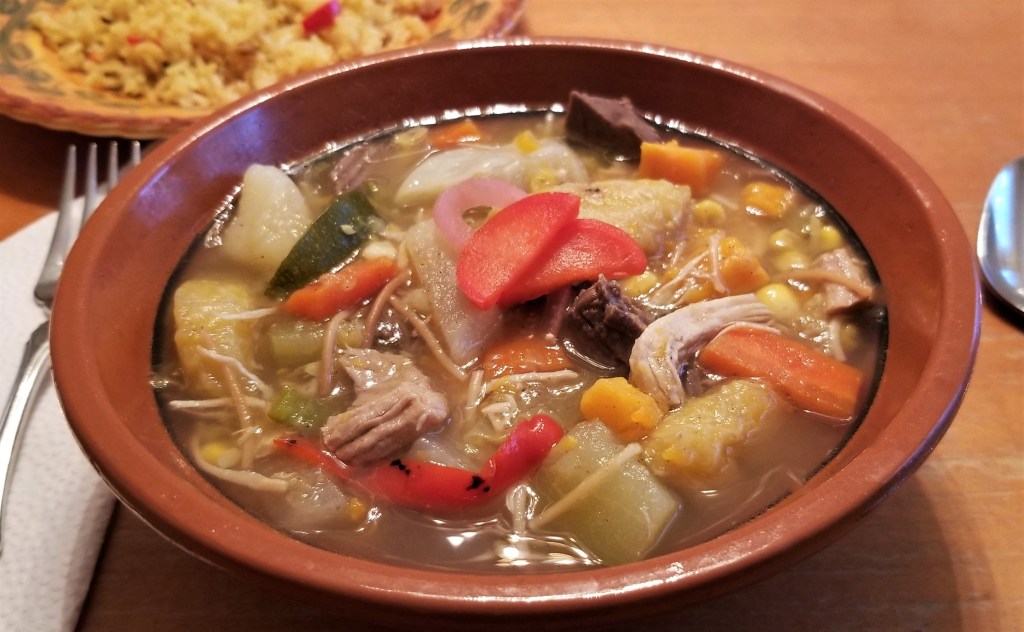
And the rice was so flavourful, with a Spanish flair from the saffron:
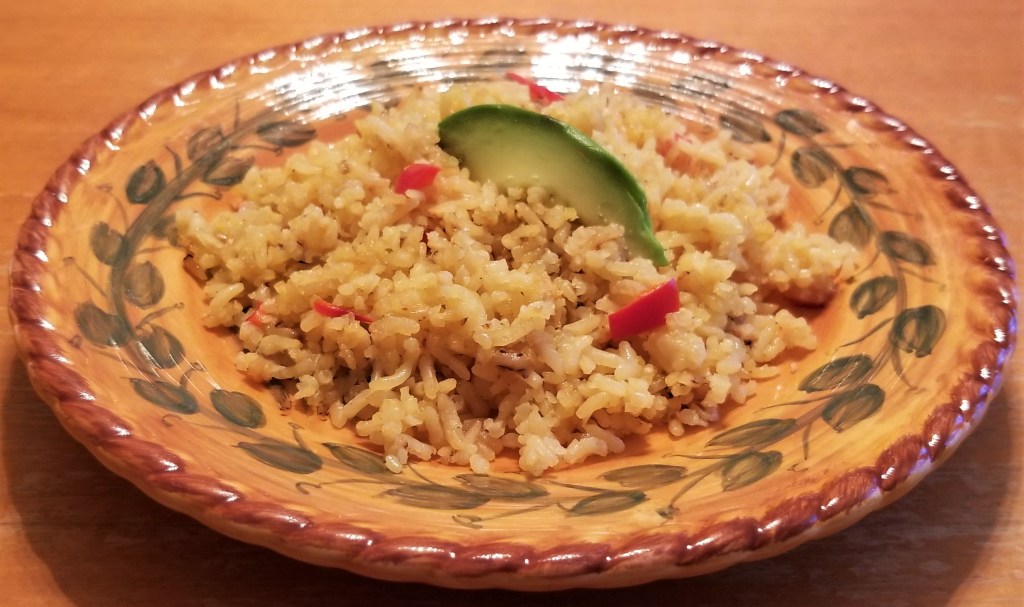
I downsized the recipe as much as possible, considering that it would make no sense to ask for half of some vegetables (like potatoes, etc.), and must confess that I was a little concern by the amount of puchero to be consumed by three people in my household; the horror of getting sick of eating the same dish, day in and day out; will it go to waste or could I freeze some? It turned out to be such a delicious, low-calorie, and almost addictive plate, that after three days, we are down to the last bowl, and my fears have switched to trying to avoid a fight over who will eat it today (LOL). If anybody tries the recipe and has a chance to freeze some, please let me know how that worked out.
A friend who lives in Virginia, in the US, asked me a while ago if I had a recipe for a wonderful “Mexican yellow rice” like the one she had enjoyed at a restaurant; sadly, I had not, but now I can send her this link to the recipe for Saffron Rice and I hope she will be pleased with it, even if this rice from Campeche is not exactly the same she had. Greetings to all who enjoy Mexican food in Virginia!
Tracy @ Reflections of an Untidy Mind was wondering if kohlrabi would be a good substitute for potatoes, for less carbs. As a comparison, 100g grams of potatoes have 17.5 g of carbohydrates, versus 6.2 g for the same weight worth of kohlrabi, so the latter is definitely lower in carbs. Kohlrabi is also an excellent source of calcium and potassium, and has good amounts of fibre and vitamin B6.
In this post, both kohlrabi and potatoes were used, and added to the pot almost at the same time. Taking one piece of each, this is how they looked on the outside (photo below, left) and in cross section (right):
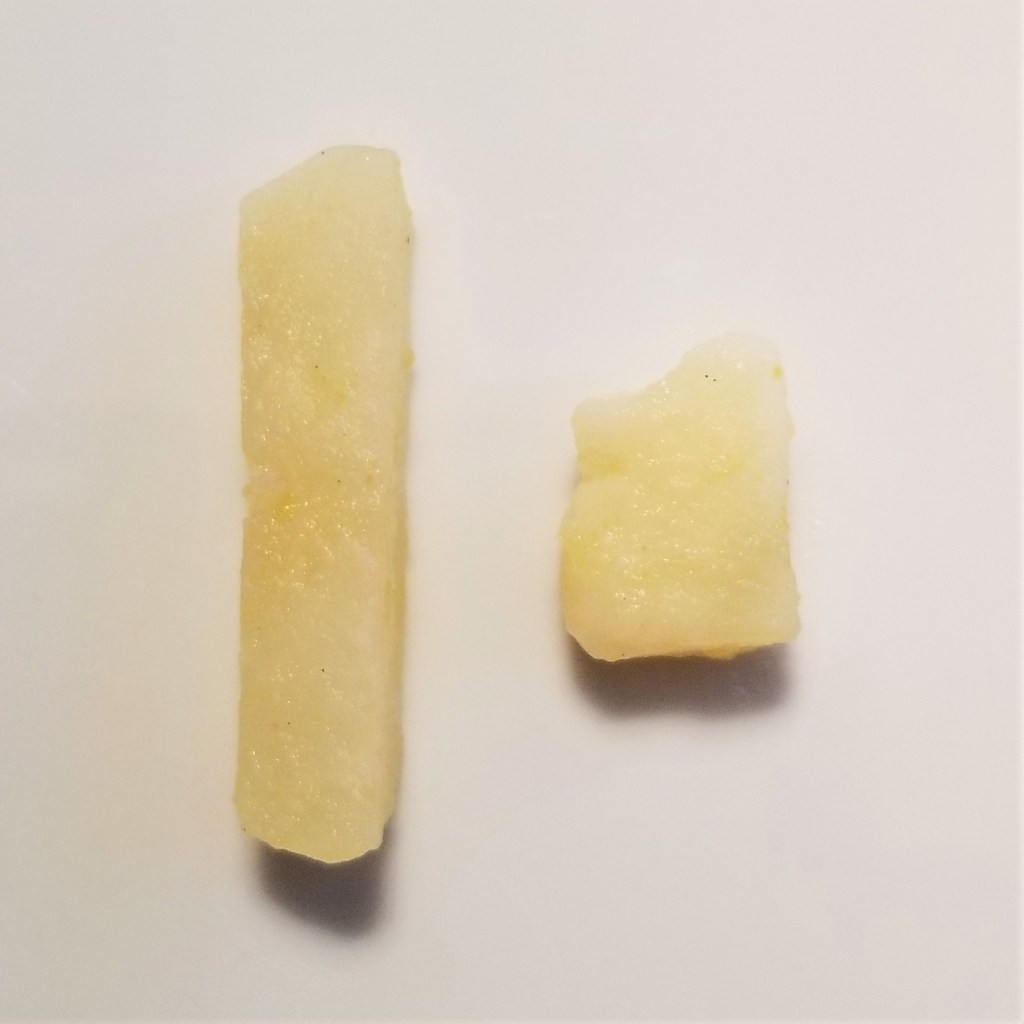
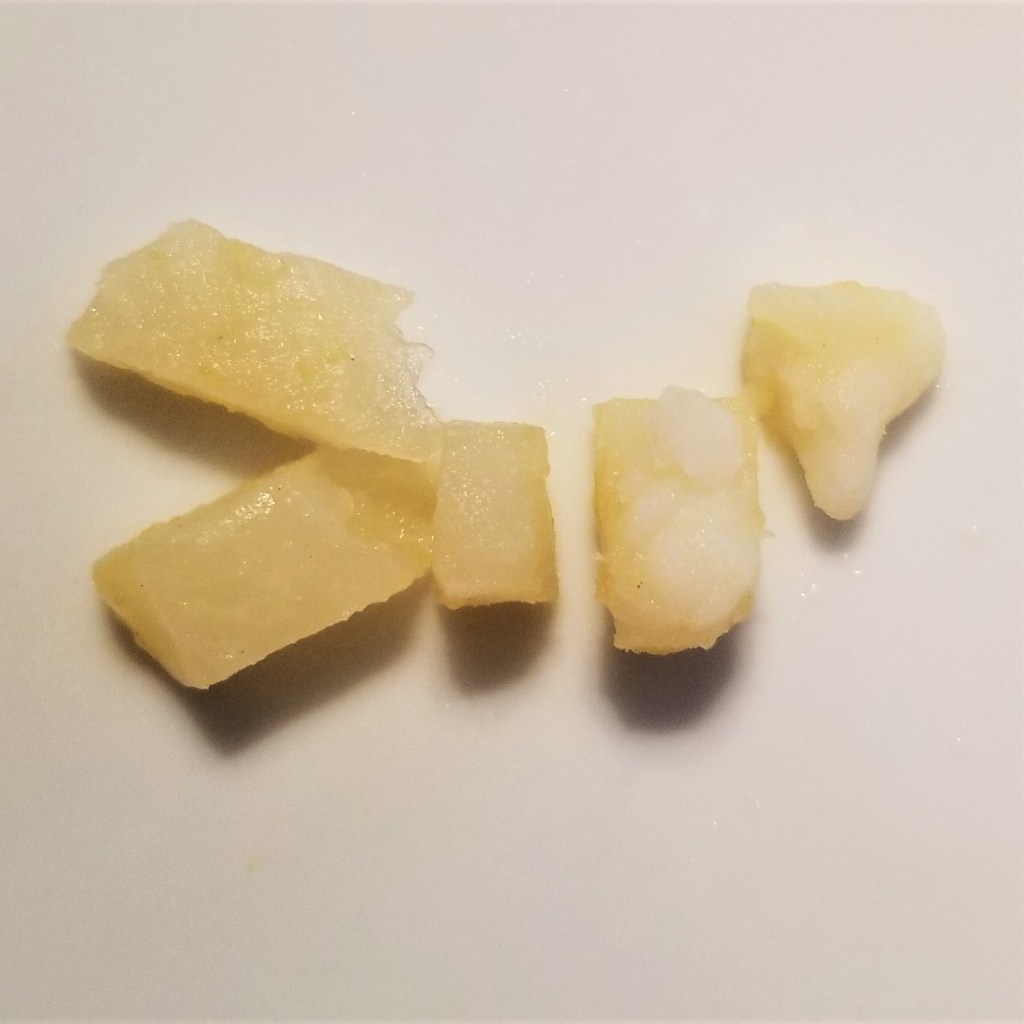
Although different in texture, the taste is mild for both, so omitting the potato, and using one more kohlrabi instead, would work well to reduce carbs without breaking the balance of this dish.
The Kitchn suggests trying kohlrabi and do not vacillate when using this great veggie instead of any other in the same family (such as cabbage, broccoli stems and radishes), when raw; they go further to also encourage its use in casseroles instead of turnips, and … to take the place of potatoes in soups, or latkes! Now, that last one is an extra yummy suggestion, that I might try soon.
Thank you kindly, Tracy, for an interesting question that has opened up more opportunities to cook with kohlrabi, and also for making my day by saying that you are using my backyard gardening stories as a guide as to what you might be able to successfully grow in your own garden (in Australia!) Kohlrabi is definitely a keeper in my backyard.
I am sharing my recipe at Thursday Favourite Things #448 with Bev @ Eclectic Red Barn, Pam @ An Artful Mom, Katherine @ Katherine’s Corner, Amber @ Follow the Yellow Brick Home, Theresa @ Shoestring Elegance and Linda @ Crafts a la Mode.
I am bringing my recipe to Full Plate Thursday #493 with Miz Helen @ Miz Helen’s Country Cottage.
When I went to link this recipe at Fiesta Friday # 337, with Angie @ Fiesta Friday and Jhuls @ The Not So Creative Cook, I was thrilled to see my Mantecadas post being featured. Thank you so much to Angie and also Liz @ Spades, Spatulas and Spoons for choosing my recipe.








Lovely Irene!
LikeLike
Thank you, Jennifer!
LikeLiked by 1 person
That dish looks lovely, Irene.
That was a question here on Millionaire literally last night! You have that show. don’t you?
It was a valuable question, I think for £250,000 – the third-last question. Let me try and remember…the question was “what is the body of water called between the Gulf of Mexico and the Caribbean Sea?”
One of the options had something to do with Windward, she said that and lost all the money. But that was the first time I ever came across that word – I think the answer was the Campeche Channel.
LikeLike
I think that’s the Yucatán Channel, just a little up North from the state of Campeche, but the land point in Mexico is Cape Catoche. Wow, and I am just preparing a post or two about the state of Yucatán!😁
LikeLike
Gosh, yes, that was one of the options too, So I guess every option must have been real and in that general vicinity/
LikeLike
Ugh, and they lost all their winnings 🙁
LikeLike
Yup, that part she was silly. That kind of money pays off the mortgage.
LikeLiked by 1 person
Looks yum, Irene! I may try it in future when the weather is more pleasant. Will keep you updated.
LikeLike
Thank you, Punam!
LikeLiked by 1 person
You are welcome.
LikeLiked by 1 person
So beautifully done. Again. When COVID19 bites the dust, are we all invited over for dinner?
LikeLiked by 1 person
Absolutely, Sue, this puchero makes enough for a crowd!
LikeLiked by 1 person
🙂
LikeLiked by 1 person
I am salivating over that, Irene. Some things taste better after a couple of days in the fridge. Epic cooking session!
Sounds like the kohlrabi is a real winner. I will look out for it at local markets (when they resume) and also try growing it. I must get my spring seed selection together. Will be fabulous having another low carb alternative, apart from celeriac, to potato.
LikeLiked by 1 person
Sounds awesome, Tracy!
LikeLiked by 1 person
Irene, can I come over for dinner? 😀 This looks delicious and the saffron rice looks so vibrant and pretty! Thanks for sharing at Fiesta Friday party!
LikeLiked by 1 person
As the Mexican expression says:”Mi casa es su casa” – “my house is your house” Thank you so much, Jhuls, and thank you for hosting FF!
LikeLiked by 1 person
Looks delicious!
LikeLiked by 1 person
Thank you, Dorothy, it was very tasty!
LikeLiked by 2 people